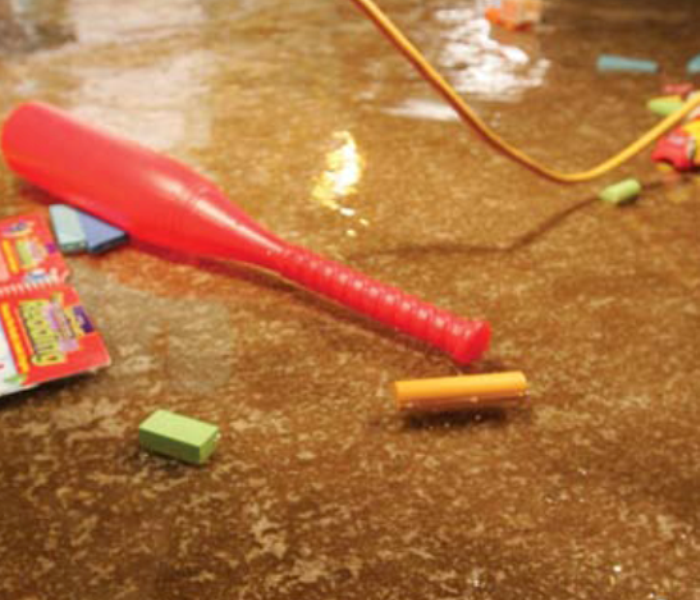Recent Water Damage Posts
Leaking Water? Tracking Down the Source | SERVPRO of Wayne
9/1/2024 (Permalink)
 Don’t let water damage linger in your home. Call SERVPRO of Wayne to restore your home.
Don’t let water damage linger in your home. Call SERVPRO of Wayne to restore your home.
After years of homeownership, you are a pro at running your home and family. You have a reliable cleaning schedule, you know the ins and outs of your utility room and everything is going smoothly.
But maybe your dishwasher has been acting funny lately or your washing machine drips on occasion. While these instances may not seem like emergencies, it is important to address these issues immediately to prevent a small water problem from turning into a big one.
We explain some reliable ways of tracking down a leak and taking control below, so read on to help ensure your home stays dry, comfortable and safe.
Where to Look First
If you aren’t sure exactly where the leak is coming from, it can be hard to track it down quickly! Water leaks can happen anywhere there is a water line or pipe, and many of those are tucked behind our walls and under our floors, safely out of sight. A single water leak can quickly make drywall soggy or swell your beautiful new wood floors, so taking action quickly is essential.
Start with any appliances that are in the room in question. Turn them off and then pull them away from the wall to check for water spots or mold growth.
If you locate the leak, find the water valve and shut it off to stop the flow of water. If not, move on to any water lines in the room. Check under sinks, around toilets and showerheads for any dripping or sounds of running water.
Finally, check around any windows or doors. Even the tiniest of cracks or gaps around a window or doorjamb can invite unwanted water into your home when it rains.
What to Do Next
Once you locate the leak and either shut off the water or set out buckets, it’s time to face the reality of your situation. Depending on how long the water leak has been occurring, you could be dealing with moisture in areas that are really hard to get to. Once water gets behind your walls or under your floors, it can quickly lead to serious issues like mold growth or structural integrity problems.
Try to stay out of the water while you take some photos and figure out your game plan. If the water leaked down your walls, the water could have gotten into the outlets and become electrically charged, so stay high and dry as you move around to open windows and turn on fans. After that, give us a call so we can make our way to you.
The SERVPRO® Restoration Plan
While you may think that tackling a water leak with a simple mop and bucket will be enough, chances are that the water that has made its way into those hard-to-reach areas will be much trickier for you to get at without professional help. That’s where we come in!
Our industrial blowers and air movers will ensure every drop of moisture is removed from your space, and we will also be able to help restore any damage that your home has suffered as well.
Our team can replace soggy drywall, restore warped floors and tackle ceiling damage with confidence. We can also help identify the reason for the leak and help with repairs in that area as well! We are here to make sure your home is returned to its preloss condition no matter what.
Dealing with a water leak? Call SERVPRO of Wayne right away.
Staying Dry During Rainstorms | SERVPRO of Wayne
3/15/2024 (Permalink)
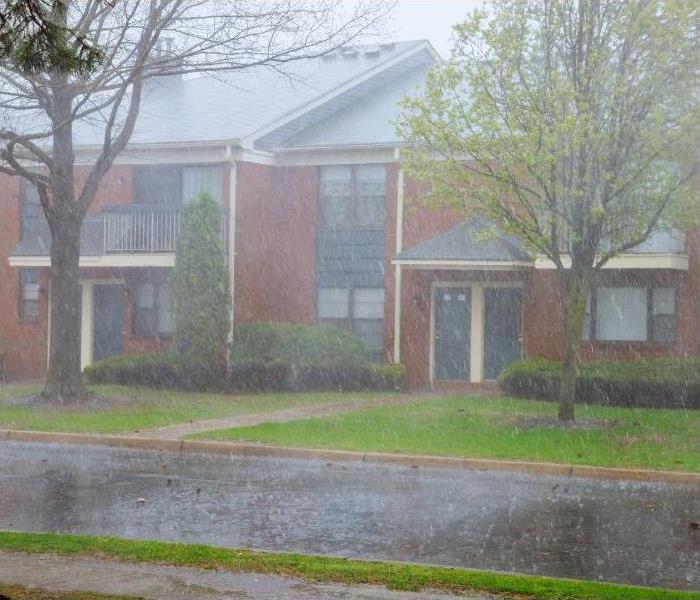 Spring showers shouldn’t ruin your property! Call SERVPRO of Wayne is ready to respond to your call anytime.
Spring showers shouldn’t ruin your property! Call SERVPRO of Wayne is ready to respond to your call anytime.
When rain comes to town, we all head to the safety and shelter that our homes provide. There’s nothing better than cozying up by the window and watching the rain fall while staying warm and dry inside.
Our homes are really durable and most of the time they are reliable, but they aren’t invincible. If your home experiences any sort of damage, it can lead to serious water leaks and the rain can easily infiltrate your home. We offer some reliable ways of staying dry when the next storm arrives below!
Getting Ready
To start with, you should always know what to expect when it comes to the weather. Tune into the forecast every day and check the conditions regularly so you are informed about what’s to come. Even if the day starts out sunny and bright, there is no guarantee that it will stay that way! If there is a storm on the horizon or a weather watch is issued, you can take action right away to help you stay safe.
Start preparing your home by making sure your gutters are clear and free of debris. Blocked gutters force any rain that falls to back up onto your roof, or it can spill over the side of your house and fall directly into your foundation.
You should also take the time to make sure all of your windows and doors are securely shut. This may seem obvious, but a single cracked window can let in an impressive amount of rain that can leak down your walls.
Checking Your Roof
This task should be done regularly and especially after a severe storm rolls through the area. Our roofs are the first line of defense when storms hit, which means they are prone to suffering damage if the conditions are right. If your roofline has gaps or cracks along it, water can easily get into your attic and wreak havoc.
Spend time going over your roof carefully, and check shingles and vents to make sure everything is in order. If you notice damage or see that something is amiss, you will have the time to fix it permanently or even temporarily before the rain starts to fall.
Addressing Water Damage
Even if you take the time to prepare your home, we all know that Mother Nature has a mind of her own. You might still be surprised with water in your basement or with water damage around a seemingly airtight window!
That’s where we come in. We understand that water damage is time-sensitive and that the longer the water sits on your floor or leaks behind your walls, the worse the situation can become.
We will jump right in to dry out your space and address any warped floors or soggy drywall. In addition, we can also take a look at the source of the leak and see if we can help prevent the situation from happening again! Our water damage restoration team is always here to help.
A simple rainstorm can have a big impact. Contact SERVPRO of Wayne right away if you discover water damage.
Detecting and Preventing Residential Water Damage in Wayne
9/30/2022 (Permalink)
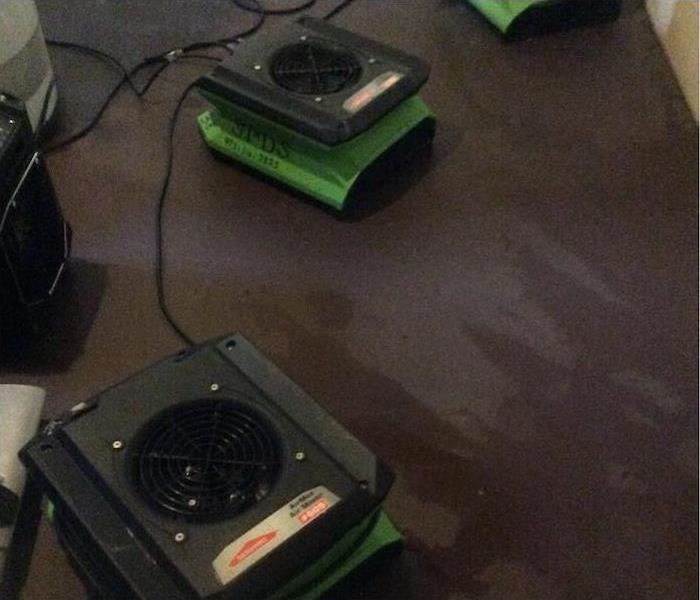 SERVPRO water damage restoration specialists in Wayne have the training and experience for every size disaster.
SERVPRO water damage restoration specialists in Wayne have the training and experience for every size disaster.
SERVPRO Water Removal Services for Wayne Homes
Disasters can happen anywhere and anytime, especially when it comes to water damage. Whether pipe fittings give out, plumbing leaks, or appliance supply lines loosen, this excess moisture can quickly welcome moisture and microbes into walls, floors, baseboards, and home contents. However, fast action and detection strategies can minimize these disasters' impact on Wayne properties.
SERVPRO water restoration technicians save Wayne properties with Institute of Inspection, Cleaning and Restoration Certification (IICRC) training, state-of-the-art tools, and around-the-clock availability. These factors help homeowners see faster relief from disaster, and more comprehensive repairs, reducing overall costs.
Reducing Damage to Wayne Properties with Water Detection and Prevention
While disasters caused by plumbing and fixture failures are nearly inevitable for most homeowners, the factors that can exacerbate them can be minimized with preparation, inspection, and detection equipment.
- Home water alarms are invaluable for detecting moisture near vulnerable areas.
- Annual or semi-annual inspections of fixtures can detect vulnerabilities before a disaster occurs.
- Make sure basement sump pumps are operational.
- Draining water heaters at least once or twice a year, and replacing them if they are over eight years old, can go a long way toward minimizing appliance failure.
- Know where the home’s water main shutoff is for when disasters occur to reduce the impact of moisture.
Some signs of damage already existing on the property include unusually high water bills, changes in water pressure, stained or soft drywall, and musty odors that may indicate the presence of mold. When these disasters do strike, contact insurers and licensed restoration professionals as soon as possible to remediate damage and keep the property safe and structurally sound.
Restoring Water Damaged Property with SERVPRO Tools and Techniques
SERVPRO water removal tools mitigate moisture through extraction, air movement, and dehumidification. Moisture extraction with portable or truck-mounted units ensures minimal water remains for air movers and dehumidifiers to counteract, significantly accelerating the drying process.
Other restoration tools in SERVPRO’s distinctive green emergency response vehicles include:
- Inspection tools like penetrating moisture meters for carpet and non-penetrating sensors for nonporous surfaces and drywall. Thermal imaging cameras are invaluable for finding moisture hidden behind walls, ceilings, and floors.
- Commercial-grade polyethylene sheeting establishes drying chambers and forces air into tight spaces with air movers. These chambers are especially useful for open floor plans, drying wet hardwood, and drying ceiling cavities and drop ceilings with minimal demolition.
- Floor cleanup services depend on the material, but carpet and pads are often salvageable with the help of hot water extractors and EPA-registered biocides. Careful extraction, tenting, and drying with air movers and dehumidifiers restore the carpet to a pre-disaster state before being reinstalled and re-seamed by SERVPRO professionals.
- Odor control tools, including ultra-low volume foggers, pump sprayers, and time-release malodor removal pellets, can combat unpleasant water odors and restore indoor air quality.
IICRC-Certified technicians can implement repairs and fresh paint, among other rebuilding services, to return the affected area to a pre-disaster state free of moisture damage, stains, and odors. Many disasters do not require extensive repair or replacement of structural materials. Still, when it is needed, SERVPRO can replace drywall, carpet, and other home essentials. Belongings are also sanitized, dried, and deodorized.
SERVPRO of Wayne is available around the clock to render mitigation that leaves properties looking and feeling "Like it never even happened." Call the team at (973) 546-4977 for restoration services.
How Dishwashers in Wayne Cause Water Damage and How to Prevent It
6/27/2022 (Permalink)
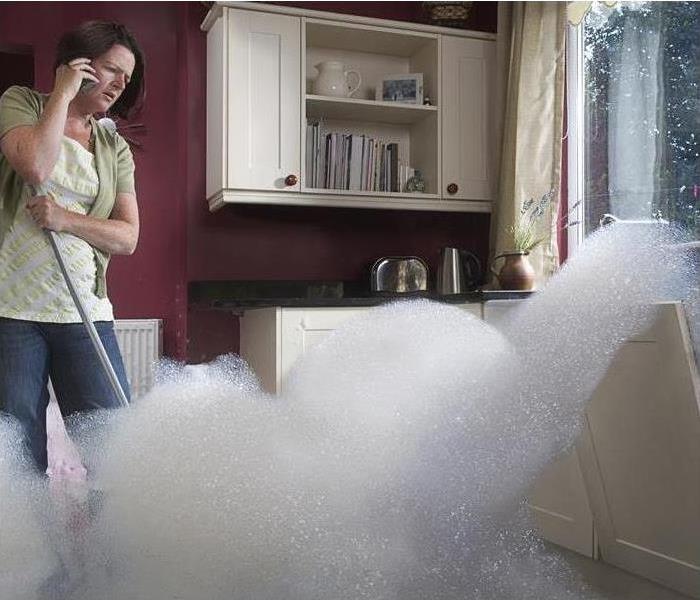 SERVPRO will have you back to your daily routine in Wayne in no time from water damage!
SERVPRO will have you back to your daily routine in Wayne in no time from water damage!
Don't Let Your Home Appliances in Your Wayne Residents Stop You
2019 has been an atypical year for us so far. While most of our typical water damage problems involve leaks, pipe bursts, and floods that get out of hand, we have so far helped three local homeowners dealing with water damage from their dishwashers. While kitchen appliances can, like any object connected to a water line, spring leaks and possibly cause much larger spills, it is unusual to see the same problem happen multiple times. Here's a brief overview of what water damage from your dishwasher might mean and how you can prevent it in the future.
How Dishwashers Cause Damage
The severity of the water damage to your Wayne home depends on how the appliance malfunctioned. A tiny leak can cause substantial damage to your cabinets and floors over significant periods. You should be able to apply on-the-spot repairs with the help of a commercially available sealant product designed to resist and contain water.
Sometimes, however, much more substantial problems can arise with these appliances. Should a water line rupture or sustain an enormous crack, it might start to flood the area. These are the situations where most people call for a professional damage mitigation company like SERVPRO. Quickly drying up water prevents costly long-term water damage problems and keeps repair costs low. However, we also get called in when long-term leaks cause issues such as oxidation and mold growth that require an expert touch to resolve.
Preventing Future Problems
As we mentioned before, commercially available sealant products can help patch up many appliance-related issues without needing to call professionals. However, these are temporary fixes rather than long-term solutions. As your appliances age, they may malfunction and cause substantial home damage increases substantially. Any time you conduct maintenance or renovations on the appliance or anything surrounding it, you should check its water lines and connectors to look for signs of damage or leaks. Most models support aftermarket upgrades and replacements for these parts, allowing you to get more years of service out of your belongings without risking additional home damage.
When problems grow, and the situation seems overwhelming, SERVPRO of Wayne can help control the situation and set up restorative processes to reverse the damage in your home. Call us 24/7 at (973) 546-4977.
Are Water Losses in the Home Permanent?
4/15/2022 (Permalink)
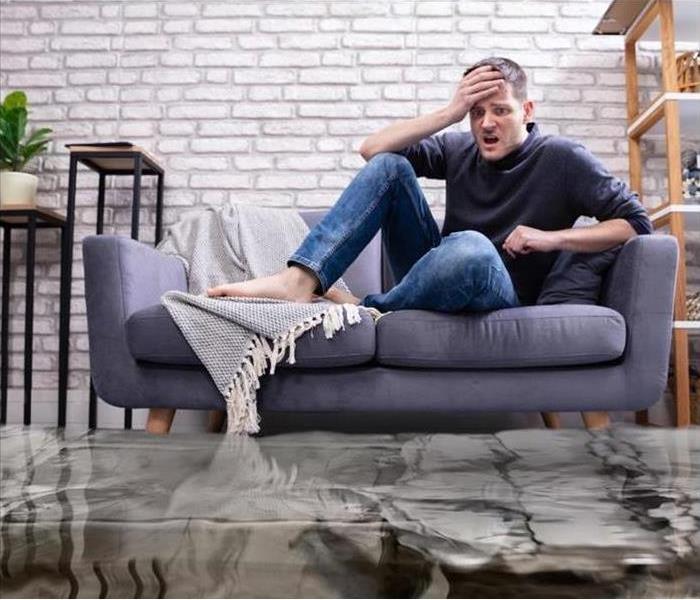 Call SERVPRO of Wayne to mitigate your water damage issues at home.
Call SERVPRO of Wayne to mitigate your water damage issues at home.
Permanent Losses Can Occur as the Result of Untreated Water Damage. Contact SERVPRO to Mitigate Structural and Contents Loss at Your Wayne Property
Water loss occurs when home appliances malfunction, plumbing fails, or external forces like heavy rainfall lead to large quantities of moisture intruding into the home. Wayne residents may find the quickest solution to potential problems is to use professional restoration technicians. Drying and cleaning a property efficiently can reduce odor, microbial growth, and structural damage. Frequently, contents are restorable and decrease the need for you to source expensive replacements.
When Should I Seek Professional Help for Water Losses?
Once the amount of water damage in your Wayne property goes beyond a reasonable cleaning scope, it is time to bring in professional assistance. Unlike other kinds of property damages, water can get significantly worse in a short period. The timeframe for water losses is particularly sensitive because moisture can interact with and harm structure or contents. It can be overwhelming facing large-scale water loss. SERVPRO technicians are here to put a sound and efficient strategy in place for restoring your property from start to finish.
What Preparation Should I Do Before Restoring Water Damage?
- Set up a clear staging area were for tools and equipment. This staging area helps to make the workload more manageable and prevents you from cross-contaminating other rooms by traveling to and fro for equipment.
- Put in place safety protocols in the house, which is especially vital in loss sites dealing with contamination.
- Create solid engineering controls to avoid spreading water throughout the home. These controls may include establishing de-contamination areas or sealing affected areas of the home. Other engineering controls may consist of foot traffic avoidance in the affected area to prevent contamination from spreading on footwear or clothes
How Do I Stop Water Losses?
The most effective measure of preventing water loss is to extract it from your home as quickly as possible. Extracting water can become complicated if debris, specks of dust, or silts contaminate contents and structure. If large amounts of water are outside the home, for example, in groundwater flooding, then they're a risk of structural collapse from hydrostatic pressure. SERVPRO can control structural harm by pumping out two feet of water with regular cooling-off periods and inspections to ensure there is no loosening of mortar or jointing. We may need to sanitize water before pumping it out of the home to avoid contaminating waste waterways.
What Do I Need to do to Prevent Secondary Water Damage?
Controlling humidity is an essential aspect of any water restoration because it prevents the buildup of microbial bacteria, viruses, and fungi. But high humidity levels can also lead to water migration into unaffected areas of your home. One way to manage humidity is to use negative air pressure. Negative air pressure can be applied with the use of Air Filtration Devices (AFDs) with exhaust ducting set-up through a nearby window or doorway. In most situations, humidity control should be in use once it is safe to bring equipment into the affected area.
What Building Materials get Harmed by Contaminated Water Losses?
- Flooring. Hardwood flooring can frequently be restorable, although carpets, which quickly absorb contamination and water exposure, should be detached and removed from the affected area along with the carpet pads.
- Trim at the bottom of walls like baseboard as well as door and windows can become contaminated quickly but is relatively inexpensive to replace.
- Ceilings and walls may need to be removed after exposure to contamination levels category two and above. Removal can be complicated, requiring razor knives, drywall saws, rotary saws, or Kett saws
- Your heating, ventilation, and air-conditioning systems may become compromised in category two and three water emergencies. In these situations, it is necessary to dissembled for affected components to be containable or removable.
What Can I Salvage From a Water Emergency?
Most valuable contents are salvageable, provided water exposure is limited, and a cleaning or drying procedure is underway. SERVPRO technicians can use high-efficiency particulate air (HEPA) fitted vacuums to remove dry dust or debris from items. Once vacuuming is complete, we may also apply chemical agents to return your items to their pre-damaged condition. We can control the spread of micro-organisms by using disinfectants or appropriate biocides on materials. To avoid causing further harm, our technicians always pre-test chemical cleaning agents on contents to ensure that they do not respond negatively to the cleaning method.
Controlling water losses relies on timely intervention as well as expertise and equipment. To prevent water damage from becoming permanent, contact SERVPRO of Wayne at (973) 546-4977 today.
Learn How to Deal with Water Damage Remediation in West Milford
3/8/2022 (Permalink)
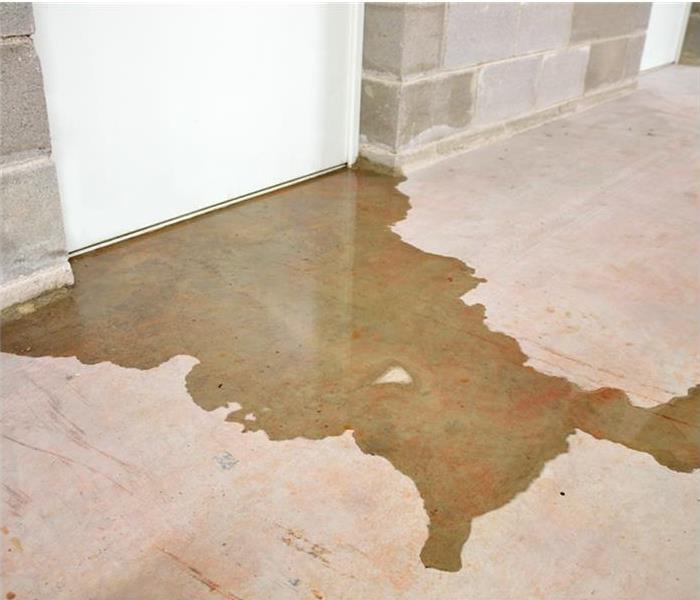 Water damage in your basement can go unnoticed. Don't let the mess accumulate. Contact SERVPRO today for remediation assistance.
Water damage in your basement can go unnoticed. Don't let the mess accumulate. Contact SERVPRO today for remediation assistance.
The Risk of Microbial Growth during Water Cleanup in West Milford Homes
A clean water spill in your property may seem like a relatively benign issue. However, large quantities of water that contact structure or contents can become contaminated rapidly. Microbes and microbial growth are present in all types of water. The longer water is present in the property, the greater the likelihood of the water itself becoming contaminated. In terms of your home and contents, more contamination results in the increasingly expensive replacement of materials. Contacting an experienced restoration handler can help control microbial growth, thereby limiting losses.
Timeframes are crucial for water cleanup duties in West Milford and the surrounding area. Microbes- including bacteria, fungi, and viruses- multiply in a typical home environment. Conditions for the growth of microbes are a food source, ideal temperatures, and moisture. Food sources are abundant in a home environment, including woods, insulation, dirt, and paper. With moisture from leaky plumbing or insecure roofing, a clean water emergency can quickly deteriorate into a grey or black water emergency.
Microbial issues get worse as time passes. The first duty for a SERVPRO water damage restoration technician (WRT) is to remove excess moisture through evaporation. We achieve this using extraction equipment for efficiency. Tenement buildings that have restricted access can be restored using portable extraction units. A larger surface area may benefit from more powerful truck-mounted extractors. Once excess moisture is vacuumed or pumped out, the remaining task for SERVPRO is to remove moisture using rapid air movers.
Rapid air movers establish air circulation at a surface level while heating elements to raise the surface temperatures and further encourage evaporation. A side-effect of this process is increasing humidity levels, leading to ideal conditions for microbial growth. A SERVPRO restorer can control relative humidity using dehumidification to combat this side-effect. Reducing relative humidity to below 60% can control microbial growth and prevent secondary damages, including mold infestations.
Properties with water issues are also at risk of bacteria, fungi, and virus growth. Contact SERVPRO of Wayne at (973) 546-4977 for professional restoration.
How Can Homeowners Perform Water Damage Repair in Pompton Lakes?
2/11/2022 (Permalink)
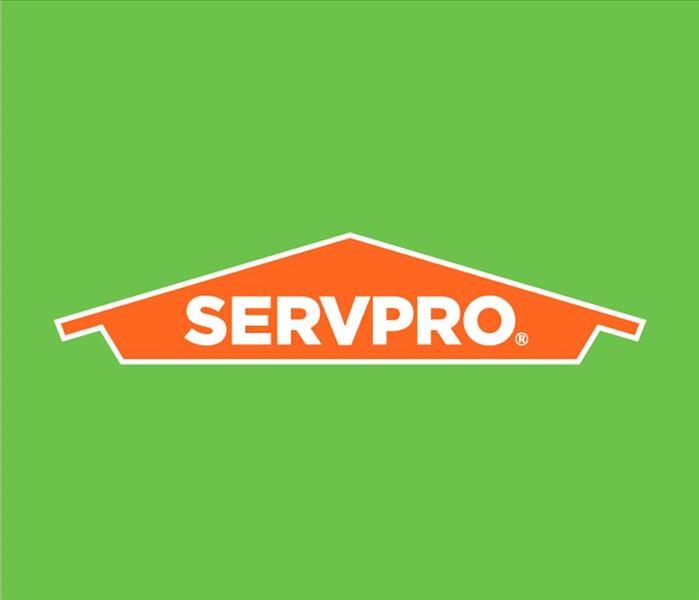 SERVPRO water damage restoration specialists have the training and experience for every size disaster. We are ready 24/7 365 days a year.
SERVPRO water damage restoration specialists have the training and experience for every size disaster. We are ready 24/7 365 days a year.
They Can Hire SERVPRO to Handle Water Damage in Pompton Lakes
Water damage resulting from seeping water is progressive and may permanently damage valuable items. This is especially true if emergency response fails to arrive within the first 48 hours. If your home has water damage, you can trust SERVPRO to start the water mitigation process quickly.
Our team is available 24/7 to handle water damage in affected Pompton Lakes homes. Our staff is well-trained to restore homes to their former state. SERVPRO’s water damage repair process includes:
- Water damage assessment
- Water extraction
- Cleaning and restoration of contents
- Structural drying
- Structural restoration
Water Damage Inspection
Our SERVPRO water damage restoration technicians can assess the affected areas to determine if it is possible to decontaminate and restore affected structures and contents or if we should remove and replace them. The decision to replace or repair depends on a material’s porosity, pretest results, and the nature of contamination.
Water Extraction
We often use portable extractors to remove water from floors in water-damaged homes. It is possible to take portable extractors into different areas of a building, including restricted areas. They have three main components: a vacuum system, a pump, and a heater.
Cleaning and Restoration of Contents
Water can ruin some essential belongings. We can salvage many of your belongings with our content cleaning technology, restoring them to as close a new as possible.
Structural Drying
Our SERVPRO technicians place air movers to deliver fast airflow to damp surfaces. To dry a home effectively, air movers and dehumidifiers must work together. The air that flows from air movers reflects off surfaces and walls, increasing evaporation and circulating air. As moisture evaporates from the building into the air, dehumidifiers remove it from the air. They offer a continual source of dry air to enhance the restoration process.
Structural Restoration
At this stage, our crew handles any necessary final repairs to the home to restore it to its original condition.
SERVPRO of Wayne offers efficient water restoration services. Call us any time at (973) 546-4977. We’re Faster To Any Size Disaster.
Where to Get Water Removal Services in Wayne
1/25/2022 (Permalink)
 Water damage restoration services by SERVPRO are top-notch. We use the latest equipment and technology for every disaster.
Water damage restoration services by SERVPRO are top-notch. We use the latest equipment and technology for every disaster.
SERVPRO Offers Proper Water Removal Services in Wayne Residences
Recovering from water damage can be an arduous and lengthy experience for any homeowner. However, working with experienced water restoration professionals simplifies the recovery process. SERVPRO can help you fix the damage and get your residence to its former condition quickly and effectively.
Our team can use diagnostic tools to assess the damage and use advanced equipment to perform water removal in your Wayne home. Our specialists are trained and certified by the Institute of Inspection Cleaning and Restoration Certification (IICRC). If there are hidden leaks, our restorers can find their source. Our water remediation process includes:
- Assessing water damage.
- Locating and repairing the source of the leak.
- Water extraction.
- Drying affected building materials and possessions.
Our SERVPRO team has diagnostic tools that help us locate moisture on various surfaces. For instance, we can use moisture sensors to detect moisture in carpeting and padding. Moisture sensors have sharp probes that penetrate through carpets and pads to determine if water has migrated into the subfloor underneath. When moisture is present, the sensor offers a visual signal through a blinking light and an audible beeps signal.
To remove water from flooring, we can use different extraction tools like light wands, deep extraction tools, extraction units, and submersible pumps. Our SERVPRO team considers the depth of water to be extracted, the distance within a structure, and power availability to determine whether to use extraction units or pumps.
When restoring a home, we also create a drying goal. This is the condition we want to bring in the affected areas of a structure. We monitor the drying process to determine if we are attaining it. The drying goal indicates the conditions that materials and contents should display after restoring them to their preloss dryness. Our drying goal includes:
- Moisture readings for dry, unaffected structures and contents
- Readings in points for non-wood materials.
- Readings in percentage for wood materials.
SERVPRO uses air moving and dehumidifying equipment to dry affected structures and contents effectively.
SERVPRO of Wayne can help you to remove water and dry your home. Call us at (973) 546-4977. We’re Faster To Any Size Disaster.
How Do I Get this Water Leak in My Kitchen Cleaned Up?
1/15/2022 (Permalink)
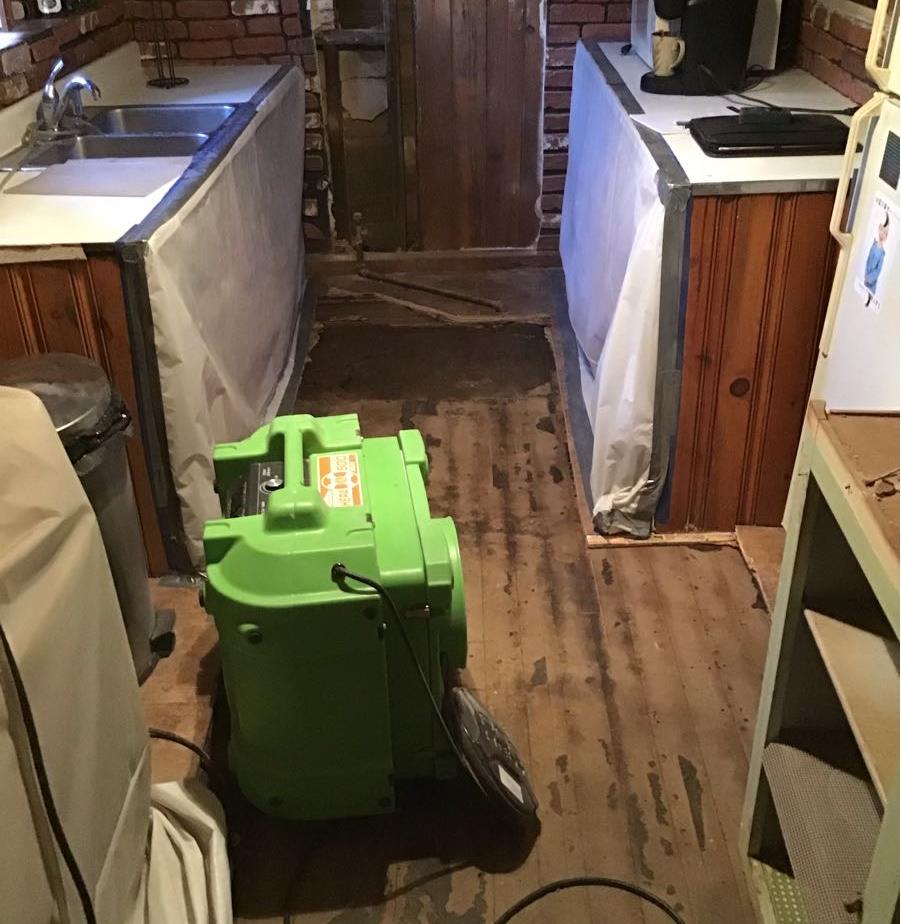 SERVPRO teams protect kitchen appliances in Wayne during a water damage mitigation service
SERVPRO teams protect kitchen appliances in Wayne during a water damage mitigation service
Many Wayne Homeowners Rely on SERVPRO for Water Extraction and Restoration
It's Who We Are
Most homeowners in Wayne are not forced to move out of their homes following a water leak. Our timely and effective service can mitigate water damage.
What to Do with This Water Leak
Water leaks in a kitchen area are common. These water drips leading to spillage do happen. However, if you do not deal with them in a timely fashion, there could be trouble. Mold and mildew often accumulate in areas that are damp. To ensure that the water leak in your Wayne kitchen does not cause this kind of damage, you can call SERVPRO.
What Kind of Tools Do We Use?
There are many devices that we use to remove the pooling water. The following is a comprehensive list:
- Portable extractors: We use these to get rid of the pools. These are smaller tools that are in line with minor messes.
- Drying mats: These increase suction, especially on hardwood floor planks, joints, and supporting floor joists.
- Extraction wands: Extraction wands have strong suction power.
- Truck-mounted pumps: We employ these to get out larger patches of water. Sometimes you need to really get out a sizable amount of water.
- Dehumidifiers: These are used after the clean-up to prevent water from pooling again.
Can Your SERVPRO Team Minimize the Damage to Your Contents?
We strive to clean up and restore, not replace, building elements, fixtures, and personal belongings whenever possible. We understand that water damage can take a toll on your well-being, and we do our best to work quickly to make you feel “Like it never even happened.”
SERVPRO of Wayne can respond rapidly to any size of a disaster. We will help you minimize any damage to your possessions. We can help 24/7 when you call (973) 546-4977.
How Can Storm Damage Water Get Removed from Wayne Attics?
8/25/2021 (Permalink)
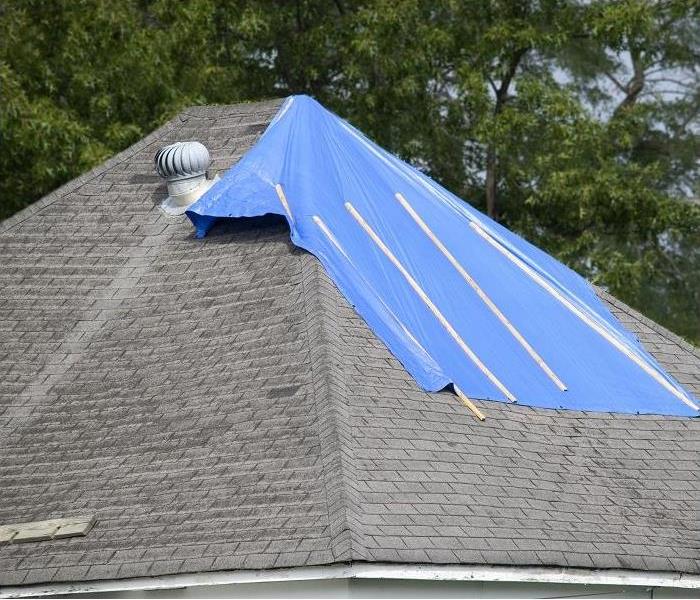 Did you know SERVPRO provides emergency roof tarping? We board up and tarp to prevent further water penetration.
Did you know SERVPRO provides emergency roof tarping? We board up and tarp to prevent further water penetration.
Removing Standing Water and Trapped Moisture Involves Several Tools Used in Wayne Homes
There is an urgency to removing stormwater and water from attic spaces. No matter the source of the harm, from intruding water after roof damage to a burst pipe or a ceiling leak, it is essential for our team to work on water removal services as fast as possible.
Repairing the Roof Damage
Before water removal for Wayne attic spaces can begin, various structural concerns must get overcome. With a general contractor license, we can immediately provide board-up and tarping to prevent further water penetration. Once water is removed and dried from the structure, we can provide full reconstruction and build-back for the damaged attic.
Removing Standing Water from Floors
Eliminating surface water is a significant undertaking for responding to SERVPRO professionals and often requires several extraction units. Deep water after concerns like burst pipes often requires submersible pumps and trash pumps. However, more minor removal needs can get met by using wet vacuums and various attachments for carpets, hard flooring, and less accessible areas.
Clearing Moisture and Damp Pockets
Water removal might often mean eliminating pooling liquid in the property, but we have measures to locate and remove hidden water caches in wall and ceiling systems. Absorption and vapor pressures can cause moisture to penetrate and overwhelm dry materials. Drying tools and strategies can be placed strategically based on data collected by moisture detection devices such as:
- Moisture meters
- Hygrometers
- Thermal imagery
With how destructive that standing water can be, mitigation solutions beginning with water removal can be critical. Our SERVPRO of Wayne team has multiple extraction devices and tools in our recovery inventory that vary based on conditions in the house. Our professionals are available 24/7 at (973) 546-4977.
When There Is An Appliance Mishap In Your West Milford Home Call Our Experts
6/25/2021 (Permalink)
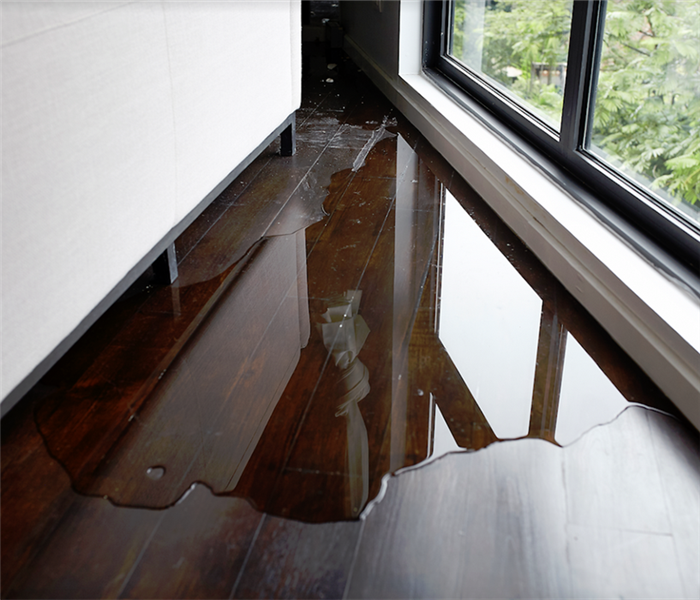 Appliance malfunctions can send a large amount of water to your floors. Contact SERVPRO for a quick response and effective water removal services.
Appliance malfunctions can send a large amount of water to your floors. Contact SERVPRO for a quick response and effective water removal services.
Water Cleanup After An Appliance Mishap In West Milford
Water damage in West Milford often traces to an appliance or some of its parts breaking down. Whether a ruptured water heater sends 50 or more gallons of water pouring through your utility room or a dishwasher pump breaks and spews soapy suds across the kitchen floor, you need help to mitigate further damage. SERVPRO's technicians will devise a professional plan to collect, contain, and dispose of the water. We are ready to partner with you.
It is critical to determine if moisture migrated away from the damage site when performing water cleanup in Milford. Even after the visible water evacuates, a substantial amount of moisture might seep through cracks and joints in flooring, causing progressive damage to structural components and exposing your home to a heightened risk of mold growth.
When we arrive, the first step is assessing the extent of the damage, including employing thermal scanning devices to locate any pockets of water that percolated below the floor or into cavities between walls. SERVPRO technicians study the science of moisture metering during their Institute of Inspection Cleaning and Restoration Certification (IICRC) training. We use devices to measure the moisture content of structural materials both as a means to map out the dimensions of the water damage and to provide accurate data for a drying plan following the cleanup.
Water deeper than two inches pumps out efficiently. SERVPRO technicians then move to wanded extractors to suction up the residual water on the surface. Specialized equipment like floor mats attached to a negative air pressure system removes water from the subfloor and the crevices between the flooring materials.
We evaluate the water's level of contaminants to determine its category for disposal purposes. Sediments and soaps mixed into supply water usually downgrade it to Category 2 or gray water. The materials contaminating the water are not excessively hazardous, but the organic materials create a possibility of accelerated microbial growth if not disposed into the sanitary system quickly. SERVPRO wants to avoid creating long-term complications, so we work hard to get it right the first time.
Rely on SERVPRO of Wayne to meet your water cleanup needs when appliances wear out or break due to needed repairs and maintenance. Call us at (973) 546-4977 for a team of experts to make it "Like it never even happened."
Water Damage Remediation Is Essential to Save Homes in Wayne
5/10/2021 (Permalink)
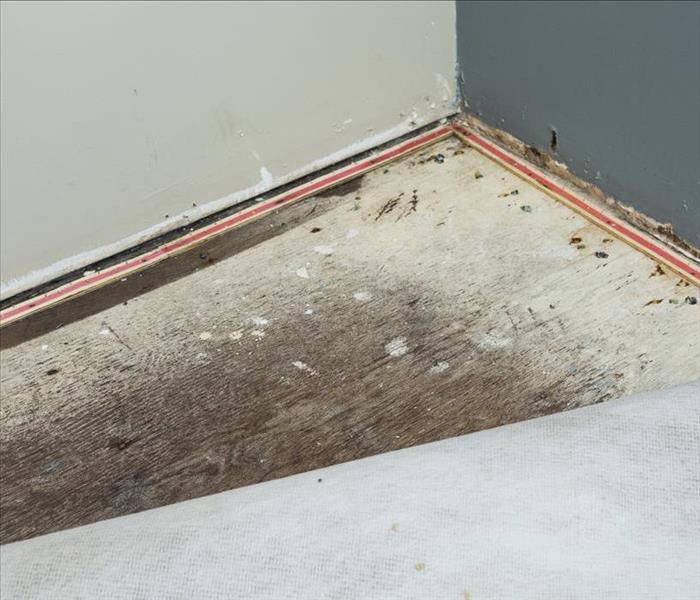 Water damage restoration for your home should be handled by a professional outfit. SERVPRO has you covered from top to bottom.
Water damage restoration for your home should be handled by a professional outfit. SERVPRO has you covered from top to bottom.
SERVPRO Offers Unsurpassed Water Damage Restoration Services
When water leaks occur in your Wayne home, it is important to remove the water and moisture as soon as possible. There may be permanent damage if not addressed immediately to porous materials such as particleboard, delamination of carpets, and swelling of hardwood floors. Mold can also begin growing in less than 48 hours, potentially leading to health effects.
SERVPRO provides water removal services to homeowners in Wayne and surrounding regions. SERVPRO responds in less than 4 hours from your call and can begin water removal and drying before significant secondary damage occurs. We offer the following services:
- Water Removal Services
- Water Clean Up
- Water Damage Repairs
Our service also includes drying the area impacted by the water leak to avoid the potential for mold growth. We investigate the nooks and crannies to find and remove all moisture. Our team uses moisture meters to detect water and high moisture areas without causing more damage. We can drill holes into drywall to reach the moisture and remove it while minimizing further damage to your home.
Call SERVPRO of Wayne for water removal services in Wayne and surrounding areas. We can help 24/7. Call (973) 546-4977
What Water Restoration Services Does SERVPRO Offer West Milford Residents?
4/12/2021 (Permalink)
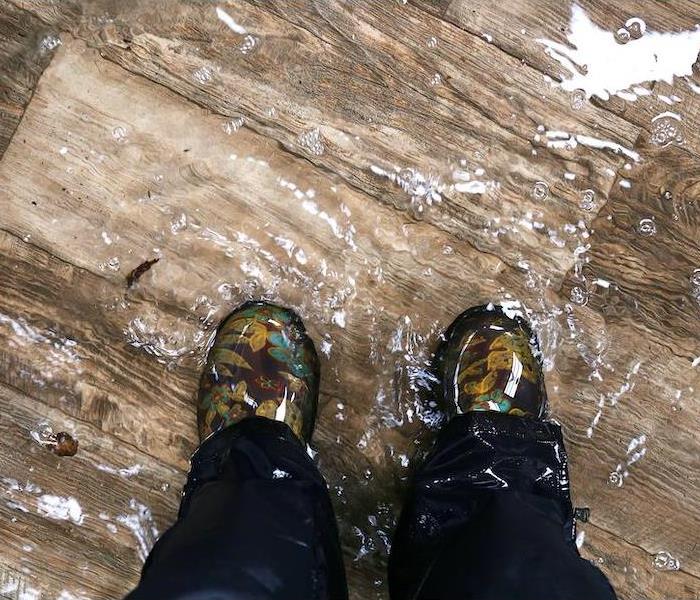 Water damage in your home is no easy task. SERVPRO has the manpower and experience for any size disaster.
Water damage in your home is no easy task. SERVPRO has the manpower and experience for any size disaster.
SERVPRO is a full-service water damage remediation company that can meet all your restoration needs in West Milford
Water extraction and remediation are different from restoration. Although, they are all part of the overall process that involves water removal services. Many residents ask what restoration is precisely. SERVPRO has the answer.
Water Damage Restoration
Water restoration to West Milford homes has many aspects. It is more than just cleaning up excess water, although that is included in the process. It is things such as:
- Relaying the carpet and repairing the subfloors
- Resetting the contents
- Restoring items to a preloss condition whenever possible
- Putting your home back together when everything is finished
The restoration process begins when the structure and contents are dry. Restoration consists of all the things that need to get done to return your home to its normal condition. During restoration:
- All repairs to contents and structure are finished
- Final cleaning and inspections get done
- Equipment gets removed from the job site
- Your things are returned to where they previously were
At SERVPRO, we care about your home and everything in it. The job is not finished until you are completely satisfied. Let SERVPRO of Wayne handle all your water damage restoration needs. Give us a call at (973) 546-4977.
Professional Water Damage Remediation to Wayne Homes
3/26/2021 (Permalink)
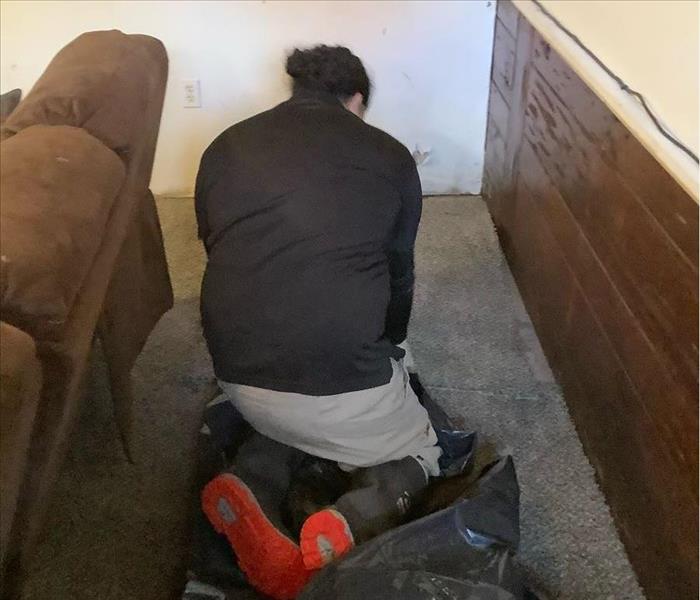 SERVPRO is a GIANT in the water damage restoration business. We are IICRC certified for any size disaster.
SERVPRO is a GIANT in the water damage restoration business. We are IICRC certified for any size disaster.
Wayne residents trust SERVPRO to provide water damage restoration when there is a problem.
Wayne, NJ, is a town steeped in history. It got its start in 1694 and played an essential role in the War for Independence. At that time, the area was part of Saddle River Township. The Dey Mansion was used as George Washington’s headquarters in the summer of 1780 and then again later in the year. The Marquis de Lafayette made his headquarters at the Van Saun House close by. The township is named after “Mad” Anthony Wayne, a Revolutionary War hero.
Wayne Public Library
Even with restrictions in place, there is still a lot happening at the Wayne Public Library. There are always virtual events going on, such as The Leonieke Jazz Trio. You can even join in a book club discussion via Zoom. They also offer online tutoring, homework help, and kid’s activities.
Famous People
Wayne is home to many well-known personalities, including:
• Dan Ackroyd - actor
• Cecille B. Demille – producer, film director
• Ryan Neill – football player
• Jessielyn Palumbo – Miss New Jersey
• Queen Latifah – singer, actress
• Louise Currie Wilmot – Navy Rear Admiral
Double Ai
If you enjoy Asian food, this is an excellent restaurant. Their fried rice is fantastic. They serve delicious meals that go beyond what you would typically expect from a Chinese restaurant. You might want to give their filet mignon and shrimp with mixed vegetables a try. It melts in your mouth! The prices are reasonable, and the staff is very friendly. When weather permits, they have outdoor dining on the patio, which is very nice.
Dey Mansion
Once known as the Bloomsburg Manor, this Georgian-style home sits on 377 acres in Preakness Valley Park. The home, which originally sat on 600 acres, was built by Colonel Theunis Dey sometime in the 1770s. It is now a museum and living history site and can be visited year-round. Theunis was a colonel in the militia during the Revolutionary War and had met Washington previously. This led him to offer his home to Washington for his headquarters in 1780. The mansion played a unique role in the war. Peak events included:
• 4 rooms were used as military war rooms by Alexander Hamilton, Tench Tilghman, James McHenry, and Robert H. Harrison.
• Visitors during that time include the Marquis de Lafayette, Major General Lord Stirling, General Anthony Wayne, and Benedict Arnold.
• While there, in July of 1780, Washington wrote over 946 pieces of correspondence and commissioned Arnold to West Point.
When you tour the mansion today, you can see the main building, a spring house, plantation house, and forge.
SERVPRO Provides Water Mitigation to Wayne Residences
Something as simple as burst pipes can lead to significant flooding and the need for water damage clean-up. A water intrusion like this requires immediate attention to prevent secondary damage from occurring. SERVPRO provides water removal services that use:
• Water extraction tools such as submersible pumps and truck-mounted pumps
• Moisture meters and probes to determine hidden moisture and moisture levels
• Industrial-strength air movers and dehumidifiers for effective drying
• Controlled demolition if necessary, to enhance the drying of structural elements
SERVPRO of Wayne is your water damage remediation expert. For help with any type of in-home flooding, contact us at (973) 546-4977. We’re Faster To Any Size Disaster.
Mold Remediation. Services Needed in West Milford
3/8/2021 (Permalink)
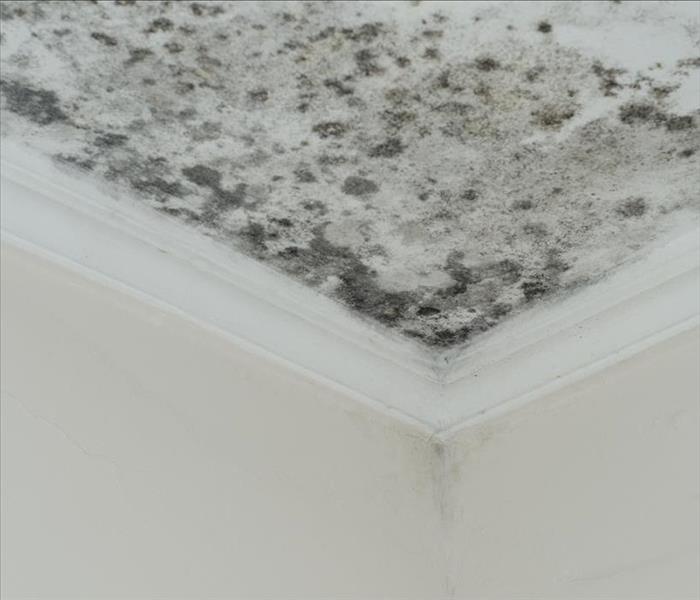 Mold remediation is no DIY project. SERVPRO technicians are IICRC certified for any size mold remediation service needed for your property.
Mold remediation is no DIY project. SERVPRO technicians are IICRC certified for any size mold remediation service needed for your property.
SERVPRO can provide quality water damage restoration services in West Milford
If a pipe inside your home breaks, the moisture can quickly soak into your walls, subfloors and increase your indoor humidity levels. Drying out your structural components can require a mixture of air movers and dehumidifiers to aid with evaporation and drying out your building materials and contents.
When our SERVPRO crew provides water damage restoration in West Milford, we must first figure out how many dehumidifiers it takes to remove moisture from the air within your affected space. The amount of dehumidifiers we use depends on the following:
- Physical Aspects of the Room: One major factor that can change the number of dehumidifiers used is how many porous materials such as carpets, upholstered furniture, clothing, paper products, and unfinished wood exist. A more considerable amount of items that can easily absorb moisture can require more dehumidification.
- The Capacity of the Dehumidifiers: Manufacturers measure a dehumidifier's ability in the following two ways:
- The machines get measured by how many square feet they can condition per minute.
- The unit's makers also test how many water gallons the dehumidifier can remove within 24 hours at 80 degrees Fahrenheit and 60% relative humidity.
If you ever notice wet building materials after a pipe breaks, call SERVPRO of Wayne at (973) 546-4977.
What Kind of Repairs are Necessary After Water Damages in West Milford?
10/31/2020 (Permalink)
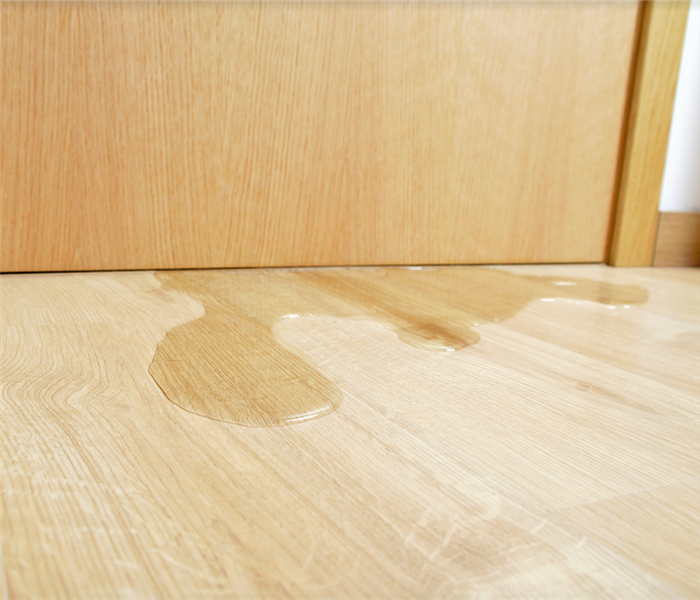 Excess water can enter your home in many ways. Contact Team SERVPRO for water removal services.
Excess water can enter your home in many ways. Contact Team SERVPRO for water removal services.
By getting repairs started in West Milford homes quickly after disasters, we can lessen losses for customers.
A fast and reliable response is what West Milford homes have come to expect after water disasters threaten their properties. Considering how quickly saturation and water penetration can threaten structural cavities and porous materials, our mitigation solutions must encompass a combination of efforts from our certified technicians and building trade professionals. After water damages, various materials can become affected, which consequently requires different construction niches to resolve. Depending on what areas of the house are damaged by the disaster, we can offer contractors experienced in masonry, carpentry, flooring, drywall finishing, and plumbing.
There are multiple phases of water mitigation for West Milford homes. The more of these actions that we can implement early on, the less overall loss that property owners experience. Because we can reach most homes within hours of the first notice of loss (FNOL), we can begin many of the vital recovery actions at this time. Apart from repairs and reconstruction necessary, mitigation typically begins with several approaches such as:
- Extraction – We have dozens of machines and devices that can remove standing water from the property. Gravity often encourages water to pool along the floors of damaged areas, leading to overexposure to porous and sensitive materials like wood flooring, drywall, and carpeting. Removing surface water can ultimately reduce saturation.
- Content Cleaning – After evaluating damages present in the house, our project manager can identify compromised contents. Cleaning up these items on-site is the ideal approach. We have solvents, detergents, and cleaning equipment to help in this effort.
- Pack Out – There are instances where on-site cleaning is not feasible or possible, even if these personal belongings are believed to be salvageable. The pack-out process moves these items to our nearby SERVPRO facility for intricate cleaning practices, deodorization, and safe storage.
What is Controlled Demolition?
Contractors on our roster complete multiple tasks beginning as soon as our team first arrives at damaged residences. Because of how quickly water damages in West Milford can spread throughout a house, it is common for some degree of controlled demolition to restore and recover the affected property. While there are varying reasons for this emergency service, it often falls into one of three categories, including:
- Access – Because repairs are often necessary to fixtures and portions of pipe, controlled demolition might be needed to access this system's points that require replacement. Using thermal imagery and other moisture detection equipment, we can identify where these damages exist to limit the amount of drywall that must get cut out and discarded.
- Safety – Sagging materials can become a substantial threat to occupants and technicians working in homes and businesses. Unmanaged sagging ceiling drywall and insulation can collapse and injure those in the immediate areas.
- Preventative – Sometimes, the actions taken by our contractors to remove portions of exposed materials like drywall and hardwood flooring are meant to prevent circumstances like moisture-wicking.
What Repairs Can SERVPRO Perform?
Emergency services are part of the initial actions that professionals on our team take to protect the property after a water damage incident. Many different approaches fit this description. While our technicians often must address pressing concerns like extraction and debris removal to prevent the spread and severity of water damages, our contractors must identify structural threats and work to repair and recover these areas. Some of the initial actions that our building trade professionals can address include:
- Plumbing Repairs/Replacement
- Board Up
- Tarping
- Controlled Demolition
Can SERVPRO Perform Complete Build Back?
Because we have a dedicated division for construction and repair, our general contractors represent nearly every building trade niche. While this can translate into the repairs and controlled demolition, it also becomes a seamless phase to follow mitigation. Our general contractors can take the remaining reconstruction and build back the property as needed to replace discarded structural elements in this phase. The experience of these professionals can also allow you to reimagine space where considerable repair is necessary. Remodeling is more cost-efficient when demolition is already required to repair property after a water loss.
Our general contractors can perform many potentially practical steps and actions to help your property recover from water damage scenarios. With many potential causes of water disasters that can simultaneously threaten your entire property, the experience and training of our SERVPRO of Wayne team can positively impact what restoration is possible for your property. Give our rapid response team a call 24/7 at (973) 546-4977.
A Leaking leaky Water Heater Has Caused Water Damage in My Wayne House. What Should I Do?
8/5/2020 (Permalink)
 We’re Faster to Any Size Disaster!
We’re Faster to Any Size Disaster!
Call Water Damage Restoration Experts in Wayne to Handle the Water Damage.
When water seeps into your Wayne property, it can cause significant damage to your valuable contents and the structure of your home. It can promote electrical hazards and lead to mold growth if not handled on time. Therefore, it is essential to call professional restorers immediately you notice the leak, to prevent further damage.
What should I do before the professionals arrive?
SERVPRO technicians can respond fast to handle the water damage in your Wayne property. However, before the restorers get to your property, you can address the primary concerns. When water seeps into items of value, we advise property owners to:
• Remain calm to maintain clear thinking.
• Identify the source of the leak.
• Turn off the main water supply.
• Switch off the electricity if water has pooled in the house.
• Place aluminum foil under the feet of furniture that is in contact with water to prevent staining.
How do you inspect for water damage?
When we get to your property, our team inspects the affected area thoroughly to determine the extent of the damage. We can use penetrating moisture meters, thermal imaging cameras, or moisture sensors to check the moisture levels. The moisture intensity readings help us make informed decisions on which technique and equipment to use during the water removal and drying process.
How do you dry a water-damaged property?
Inadequate drying can lead to an unhealthy environment and expensive repairs. After removing the water, SERVPRO technicians use advanced equipment to dry the affected areas fast and effectively. We can use axial air movers, which move enormous volumes of air from outside into the affected area. The fresh and dry air increases the rate of evaporation, leading to faster drying of affected surfaces, including the hard to reach areas. Our restorers use dehumidifiers to remove moisture from the air. We pay particular attention to the condition of plaster, wood, and wall finishes as well as other elements of a building that water has affected to ensure thorough drying.
After a water intrusion incident in your property, contact technicians from SERVPRO of Wayne at (973) 546-4977 for effective restoration services. We’re Faster to Any Size Disaster.
A Burst Pipe Has Left Me Dealing With Water Damage in My Wayne Home. Where Do I Get Help?
7/25/2020 (Permalink)
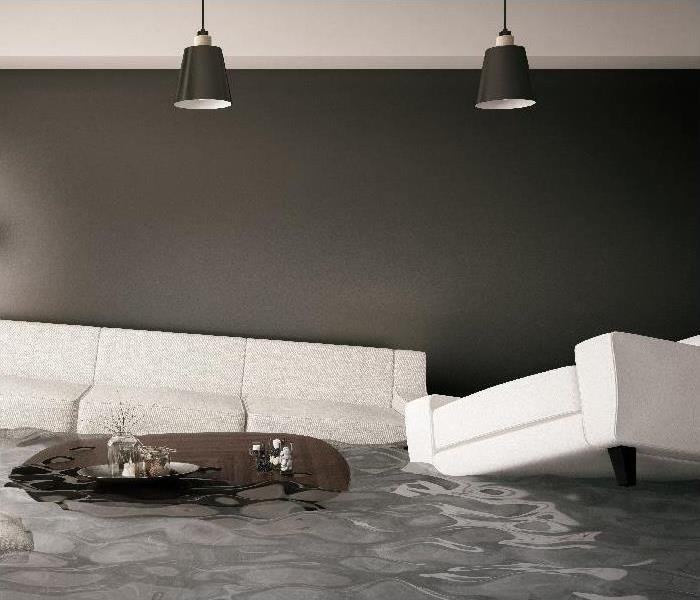 You can count on SERVPRO of Wayne for effective water cleanup services.
You can count on SERVPRO of Wayne for effective water cleanup services.
Hire SERVPRO Technicians in Wayne for Water Cleanup Services.
Water can cause extensive damage to your property’s structure, furniture, and upholstery. Restoring your Wayne property all by yourself without proper tools and equipment can cause more damage. Therefore, it is essential to hire licensed, skilled, and experienced restorers.
How far can water travel?
Water can seep into ceilings, drywall, floors, and furniture, among other valuable structures and contents. Contacting professional restorers to perform water cleanup in your Wayne property quickly is critical. If you ignore a water loss incident for some time, the degree of damage can rise exponentially. When we get to a home, we concentrate on saving as many materials and items as possible and preventing further damage.
Why should I involve professionals?
At SERVPRO, we have a licensed team of experts who have undergone thorough training in:
• Assessing affected property
• Determining salvageable and unsalvageable items
• Cleaning up the affected area
• Drying the affected materials
• Removing contaminants from your home
Apart from that, it is risky to get into an area affected by water damage since there might be uninsulated electrical wiring that is exposed to water. It may cause electrocution or fire. Our team has handled many different cases of water damage during the years we have been in business. Therefore, your property’s condition cannot intimidate us.
What damage can mold cause in a property?
After water damage, it takes less than 48 hours for mold to rear its ugly head. Poor moisture extraction can cause the mold to multiply quickly. As the mold grows, it releases small spores into the air that one can quickly inhale without noticing. Mold can cause health issues to the people who live in your home. Our technicians can dry and sanitize every inch of the flooded area properly to prevent mold growth.
How do you remove water and moisture?
At SERVPRO, we utilize cutting edge techniques and advanced equipment and products during the water cleanup process. After assessing the damage, our team can determine the best and most efficient method to dry your home. Depending on the water levels, we can use a portable electric submersible pump to extract the water.
Our team also takes measures to increase air circulation to expedite the drying process. We can achieve this by using venting box fans. The equipment increases air circulation, increasing the rate of evaporation. Our technicians also position dehumidifiers strategically in a water-damaged house to allow the humid, and moist air within the house to be moved to the units and the dry war air discharged from the units to be circulated back to the ruined areas.
Do not reschedule your plans due to water damage. Count on SERVPRO of Wayne for effective water cleanup services. Talk to us today at (973) 546-4977. We’re Faster to Any Size Disaster.
What Can Water Damage Experts do for My Soggy House in Wayne?
6/23/2020 (Permalink)
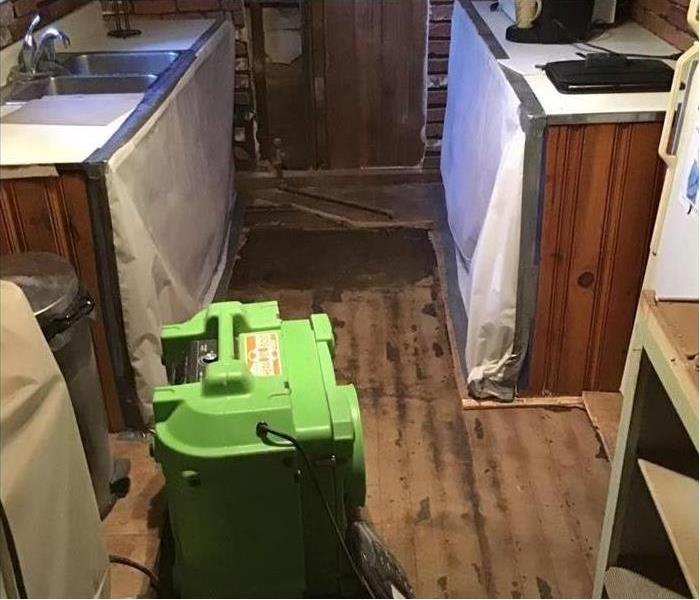 Call SERVPRO today with your Wayne water damage.
Call SERVPRO today with your Wayne water damage.
Let SERVPRO show and explain to you how we can help your Wayne water damage.
Instead of relying on your own sight when dealing with a spill, hiring a team of experienced water damage mitigation specialists in Wayne can be the deciding factor in your home’s favor. Water rapidly spreads into areas you cannot see, and as it does, it carries anything it passes. Different substances require different responses, as well, as do the different materials used to build your residence.
What Makes a SERVPRO Technician More Qualified than a Homeowner?
Our technicians, especially our Applied Microbial Remediation Technician (AMRT) and Applied Structural Drying Technician (ASD) help property owners through initial mitigation, cleanup, and restoration of water damage in your Wayne home. Water causes harm to materials at different rates, even after it has evaporated into the air. Removing the water from the interior components of a residence, and drying everything, including the air, helps prevent damage from continuing.
Extensive training prepares SERVPRO technicians in the proper use of industry-grade equipment, letting us finish the work required rapidly. Many of these items are not available, nor cost-effective, for most homeowners. On a typical water damage-related job, we use:
- Air movers,
- Desiccant machines,
- Application spray equipment,
- Water detection devices,
- Extraction machines of various types, and
- Equipment pieces designed to produce heat, air, or a combination.
Why is My Fan not Good Enough to Deal with a Washer Leak or a Clogged Sink?
Drying out the surface and exposed areas can leave you with a sense of false security. While it might seem proactive, enclosed areas (under stairs and cabinets) won’t dry out fast enough to keep mold from starting to grow. Also, materials sandwiched in between the floor and the ceiling of any downstairs areas need more than drying of the exterior surfaces. Our equipment can find hidden water. Then we can remove it, making air drying more efficient (faster completion of the job means less expense, less damage, and less inconvenience).
Dial (973) 546-4977 to reach qualified water damage technicians at SERVPRO of Wayne for such emergencies. We also assist property owners between North Haledon, NJ, Wayne, NJ, and West Milford, NJ with emergencies affecting their house or other building.
Sophisticated Moisture Detection Used for Pompton Lakes Homes
12/23/2019 (Permalink)
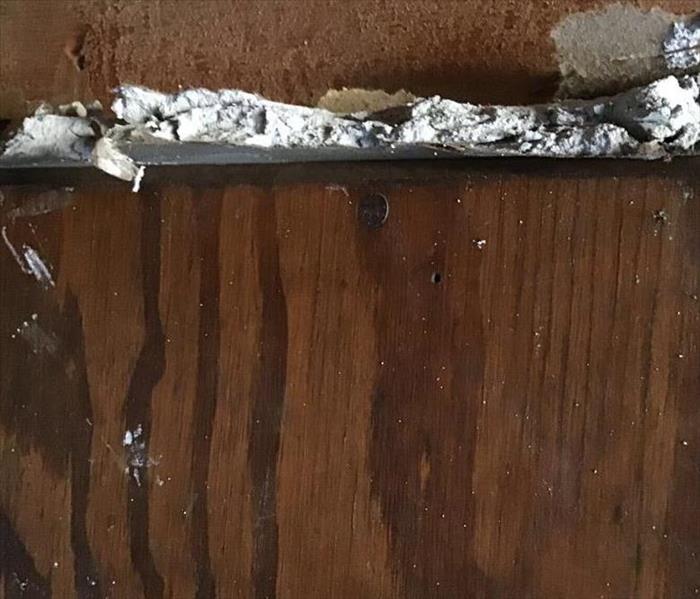 Water will take over your Pompton Lake home, moisture will take over. Let SERVPRO help you.
Water will take over your Pompton Lake home, moisture will take over. Let SERVPRO help you.
SERVPRO will always be first in line to assist your Pompton lake home water damage.
Identifying water damage in your Pompton Lakes home might not always be as easy as it seems. While there are many circumstances where dampness and even standing water are in central areas of the house, this does little to indicate the severity of the damage that you cannot see. Because our SERVPRO team devotes our qualified professionals to exceeding the expectations of our customers, we must begin by fully understanding the problems that our professionals face when we first arrive.
Water damage in Pompton Lakes home is not always readily accessible and easily seen. To determine the saturation of porous construction materials, the presence of water in moisture cavities, and the general spread of water loss effects, our team can utilize several tools. Not every moisture detection device is ideal for each situation, and in many pre-job scoping ventures, our project manager uses more than one of these tools.
Moisture Sensors
These devices can detect moisture and dampness in carpeting and the subflooring/padding. With probes that can pierce into both carpet and padding, these needles can identify the presence of moisture in these areas. The result is a pass/fail test; it does not indicate the severity of dampness.
Infrared Imagery (Thermography)
Imaging cameras that use infrared can help to show temperature differences that can indicate the presence of moisture. While it is possible to get false positives using this technology, colder areas can often mean moisture pockets that our SERVPRO technicians must focus on drying.
Moisture Meters
Unlike the other devices listed, these tools have gotten designed to identify how saturated specific materials are. These tools can get used as surface detectors or with an attached probe. Penetration can get controlled down to the very tip of the probe, allowing our technicians to gauge dampness through individual layers of the affected material.
These are a few of the cutting-edge detection devices that our SERVPRO of Wayne team uses when we must identify the scope of the water loss work to get done. However we can help, give us a call at (973) 546-4977.
To learn more about Pompton Lakes, click here.
Our Experts Discuss Our Fast-Dry Equipment For Pompton Lakes Water Cleanup
10/9/2019 (Permalink)
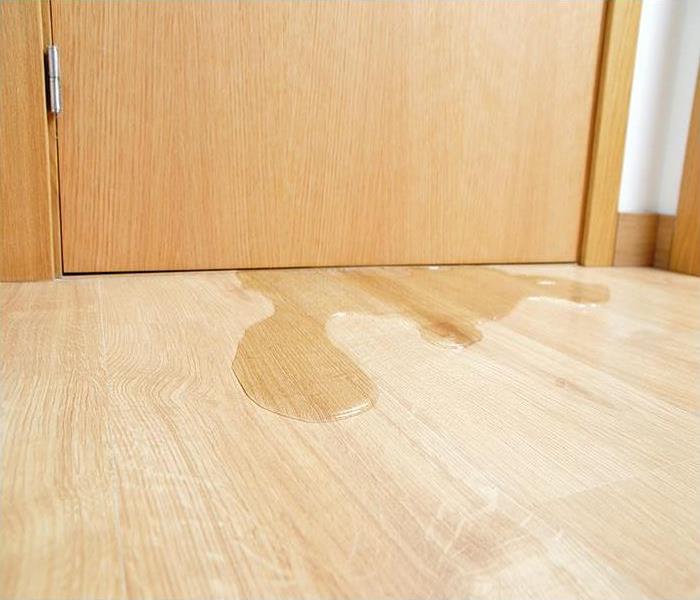 We’re Faster to Any Size Disaster, and you can reach us 24/7 for help.
We’re Faster to Any Size Disaster, and you can reach us 24/7 for help.
We Feature Fast-Dry Equipment For Pompton Lakes Water Cleanup
New Jersey homes are susceptible to potential water damage, whether from excessive rains or an appliance or piping emergency. Once a home suffers water damage, the potential for mold growth becomes a real concern that warrants prompt attention.
The team at SERVPRO is available to handle water cleanup in Pompton Lakes from dishwasher leaks to damaged piping underneath a bathroom sink. The key is shutting off the water supply to the area of the home where the water leak is present and calling the professionals to tackle the cleanup before the damage multiplies.
SERVPRO technicians arrive at your property to begin the assessment process so that water extraction may commence. We utilize thermal imaging technology to detect high moisture levels in the walls to pinpoint any areas that may remain undetectable to the naked eye. Further inspection of the baseboards and drywall allows us to implement a plan to allow the air to flow naturally into the wall cavity to shorten the drying time.
When it comes to water cleanup and getting ahead of the damage, SERVPRO technicians spend the time necessary to locate all water leaks to implement extraction processes. Cleanup is done before the drying phase so that our dehumidification and drying equipment effectively reduce the moisture levels to achieve drying goals.
We use drying equipment, known as air movers, that we place throughout the space strategically to achieve optimum airflow. Our air movers put out high-velocity airstreams that we angle carefully over surfaces within the home. This technique prompts water vapors that embedded within the walls to rise so that the dehumidification technology can capture it and remove it. Once the moisture removal process is complete, SERVPRO technicians work to clean all surfaces as a measure to inhibit the growth of mold.
Contact our team at SERVPRO of Wayne at (973) 546-4977 when you need water cleanup on your property. We’re Faster to Any Size Disaster, and you can reach us 24/7 for help.
For more about Pompton Lakes click here.
We Use Advanced Techniques In West Milford To Offer Water Cleanup
9/12/2019 (Permalink)
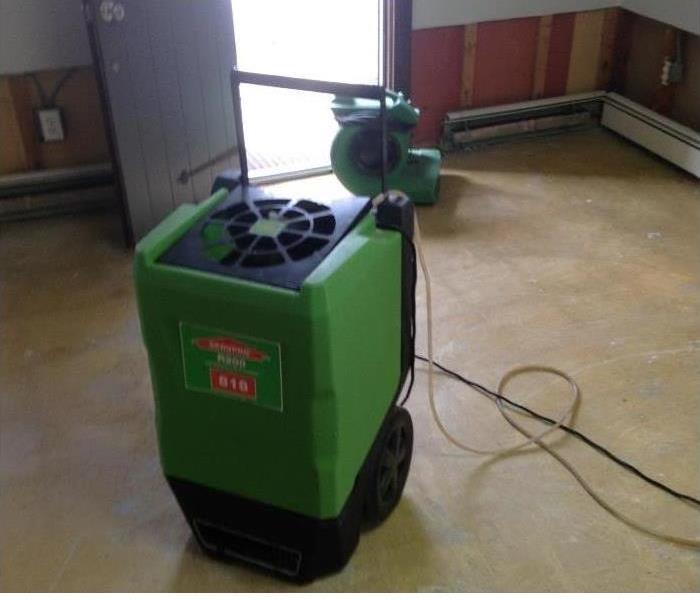 Our equipment drying the sub floor in this home and framing following a water damage disaster.
Our equipment drying the sub floor in this home and framing following a water damage disaster.
Get Appropriate Water Cleanup for Your West Milford Residence to Prevent Additional Damage
Water intrusion incidents are common and potentially destructive. The most common causes of water damage in West Milford homes are burst pipes, leaking faucets and malfunctioning appliances like dishwashers, water heaters, or washing machines. If you do not remove the excess water quickly, it may promote electrical hazards or lead to mold infestation.
When the worst happens, and you need water cleanup services in West Milford, you can trust the experts at SERVPRO. With one call, we can arrive at your home and provide specialist guidance on what you need to do. We have the experience and equipment to deal with the problem quickly. With our rapid response, we can help you restore your floors, personal possessions, and walls. We can arrive at your residence with confidence and knowledge backed by decades of field experience. Our water remediation techniques focus on removing moisture and promoting effective drying. You can expect the following when you use our water removal services:
Free estimates
Our experienced technicians can assess the water damage and provide you with a free, no-obligation estimate on how to restore your home to its preloss state.
Professional water extraction equipment
Our restorers use advanced techniques and professional-grade equipment to restore homes. We have portable extractors that remove water effectively. When extracting water from hard surfaces, our technicians use a squeegee attachment. When removing water damage from glue-down carpets, we use light wands or carpet wands. Light wands are also useful for extracting residue water on the surface of carpeting after we have used a stationary tool.
Advanced drying and moisture detection equipment
We use air moving equipment to improve evaporation at the surface level and minimize drying time. Our technicians can use axial air movers to dry your home. These devices move large volumes of air and can, therefore, cover large areas of affected materials. We also place dehumidifiers in a home to remove water vapor from the air. When drying a home, it is challenging to find all sources of moisture, especially in difficult to access areas. Our SERVPRO crew can use penetrating moisture meters to test for moisture beneath wood flooring and inside walls.
We work with your insurer
It is difficult to determine what your home insurance policy covers. We can work with your insurance firm to get much of the water loss covered and ensure a straightforward claims filing process.
When you need water cleanup services in Wayne, Pompton Lakes, or Ringwood, contact SERVPRO of Wayne at (973) 546-4977 for assistance. We can make the destruction seem “Like it never even happened.”
See more about West Milford.
Prevent Damage from Frozen Pipes
12/30/2018 (Permalink)
Source: https://disastersafety.org
Frozen pipes are one of the leading sources of property damage when the temperature drops. Don’t let damage from frozen pipes soak your home or business—prepare using the following guidance.
1. Seal Exterior
Seal all cracks, holes, windows, doors, and other openings on exterior walls with caulk or insulation to prevent cold air from penetrating wall cavity.
2. Seal Interior
Insulate and seal attic penetrations such as partition walls, vents, plumbing stacks, and electric and mechanical chases.
3. Relieve Pipe Pressure
Let all faucets drip during extreme cold weather to prevent freezing of the water inside the pipe, and if freezing does occur, to relieve pressure buildup in the pipes between the ice blockage and the faucet.
4. Keep the Building Warm
Install a monitoring system that provides notifications if the building’s temperature dips below a pre-determined number.
5. Insulate Vulnerable Pipes
Insulate pipes most vulnerable to freezing by using pipe insulation.
6. Install Early Detection System
Install an automatic excess flow switch on the main incoming domestic water line to monitor and provide early detection of a broken pipe or valve. Use wireless sensors near water sources.
7. Monitor Fire Protection Sprinkler Systems
Monitor sprinkler systems using a central station to provide early detection of a pipe failure and heat unheated sprinkler control rooms.
8. Install Backup Power
Provide a reliable backup power source to ensure heat to the building.
Contact us at 973-546-4977 if you have a service need or click here to visit our website to learn more about SERVPRO of Wayne's System Services.
Like Us on Facebook or Follow us on Twitter, Google+, or Instagram and follow the tips, tricks and advice we share with our community.
How to get federal disaster assistance
10/7/2018 (Permalink)
Source: https://www.bankrate.com
Author: Jay MacDonald
When local and state resources are overwhelmed by a severe disaster, your state’s governor will request that the president issue a Major Disaster Declaration. This is the only declaration that can activate a range of federal assistance programs for individuals and families. Assistance may include temporary housing, low-interest loans and grants, counseling for post-disaster trauma and other services.
FEMA service information to keep handy:
To register for federal disaster assistance:
Online: DisasterAssistance.gov
Phone: (800) 621-3362
Teletypewriter, or TTY: (800) 462-7585
Smartphone: m.fema.gov
To locate a mobile: Disaster Recovery Center
To appeal a FEMA grant denial, write to:
FEMA - Individuals & Households Program
National Processing Service Center
P.O. Box 10055
Hyattsville, MD 20782-7055
Or send fax to: (800) 827-8112
Attention: FEMA -- Individuals & Households Program
The Federal Emergency Management Agency, or FEMA, doesn’t activate all of its assistance programs in every natural disaster. It largely depends on the nature of damages reported by your state.
To qualify for federal disaster assistance, your losses must have occurred in an area covered by a Major Disaster Declaration. If you have online access, you can quickly determine this at FEMA’s Federal Disaster Declarations Web page.
A number of criteria are used in the determination of a major disaster area, including the amount and type of damage, the imminent threats to public health and safety, and level of insurance coverage in place for homeowners and public facilities, according to fema.gov.
Make an insurance claim
After determining whether you are in a major disaster area, you should file an insurance claim with your home and/or auto insurance company for any damages incurred. Failure to file an insurance claim may affect your eligibility for federal assistance, because by law, FEMA cannot provide money for losses that are covered by insurance.
Once you file your claim, FEMA may be able to provide some assistance in the following circumstances.
- Delayed insurance settlement: If your settlement is delayed longer than 30 days, FEMA may loan you some money. It will expect you to repay the loan when your settlement arrives. How to file: Write FEMA with a full explanation and insurance claim number, the date of the claim and documentation.
- Your insurance settlement falls short: If the maximum payment from your settlement doesn’t cover your disaster-related needs, FEMA may help make up the difference. How to file: Write FEMA with a full explanation and complete insurance documentation.
- Additional Living Expenses exhausted: If you’ve exhausted your insurance company’s maximum loss-of-use settlement, FEMA may be able to help with your disaster-related temporary housing needs. Write them with explanation and documentation.
Types of federal disaster assistance: housing and nonhousing
There are two types of direct federal disaster assistance available: housing needs and nonhousing needs:
Housing assistance. This includes temporary housing and money to help repair or replace your primary residence. To qualify for housing needs assistance, you or someone living with you must be a U.S. citizen, noncitizen national or qualified alien; your home must be your permanent residence; and you must have been living in the home when the disaster hit but not currently able to due to damage from the disaster.
Nonhousing needs. These include medical, dental and funeral costs; clothing and household items; tools; home fuel; disaster-related moving and storage; and replacement of a disaster-damaged vehicle. In order to qualify for these, you or someone living with you must be a U.S. citizen, noncitizen national or qualified alien; you must have serious disaster-related needs and expenses; and you must have accepted all assistance for which you are eligible from insurance proceeds and Small Business Administration, or SBA, disaster loans.
The SBA provides federally subsidized disaster loans to repair or replace homes or personal property of qualified homeowners and businesses. SBA loans comprise the lion’s share of federal disaster assistance.
Additional forms of direct federal assistance include crisis counseling; disaster unemployment assistance; legal services, including assistance with insurance claims; and special tax consideration that enables you to deduct a casualty loss that exceeds 10 percent of your adjusted gross income on your federal tax return for the current or previous tax year.
What’s next
Once you’ve applied for federal disaster assistance, you can check the status of your application within 24 hours via the same method you applied. FEMA will also mail you a copy of your application along with a detailed guide that walks you through the assistance process.
An inspector working with FEMA will contact you 10 to 14 days after your application to schedule a time to visit your home and inspect the disaster-related damage. There is no charge for this inspection, but you must be present during the inspection and prepared to offer the inspector proof of ownership and occupancy.
- Proof of ownership includes any of the following: deed, tax records, mortgage payment book or a homeowners insurance policy showing you as the owner. Lacking these, the inspector may be able to obtain proof from a county property tax website.
- Proof of occupancy includes any of the following: driver’s license with address, a recent utility bill in your name or any first-class government mail sent to you at your address during the past three months.
Do you qualify?
Inspectors submit their report to FEMA but play no role in determining your eligibility for assistance.
It will take FEMA about 10 days to review your inspection. If you qualify for a grant, FEMA will send you a check by mail with a letter explaining how you are to use the money (you’ll receive this via direct deposit if you supplied your bank routing number on your application).
The grant is tax-free and does not require repayment. However, you cannot give it to someone else and you must use it as specified by FEMA. If you don’t, you won’t be granted any additional assistance and you may be asked to pay it back.
If you do not qualify for a grant, you’ll receive a letter explaining why. You have the right to appeal. Appeals must be written and mailed within 60 days of receiving FEMA’s decision.
In a third scenario, FEMA may send you an application to apply for a loan through the Small Business Administration. You must complete and submit the SBA loan application to be considered for a loan as well as certain types of grant assistance. If the SBA then determines that you do not qualify for a loan, it will automatically refer you back to FEMA for grant assistance.
Contact us at 973-546-4977 if you have a service need or click here to visit our website to learn more about SERVPRO of Wayne's System Services.
Like Us on Facebook or Follow us on Twitter, Google+, or Instagram and follow the tips, tricks and advice we share with our community.
Get disaster relief from the IRS
9/5/2018 (Permalink)
Source: https://www.bankrate.com/finance/money-guides/disaster-relief-from-the-irs-1.aspx
Author: Kay Bell
After people endure a disaster, taxes are probably the last thing on their minds. But tax laws do offer some help for loss victims. And victims of a presidentially declared disaster could use their tax filing to obtain much-needed cash.
Taxpayers who itemize are allowed by the IRS to deduct casualty losses — “the damage, destruction or loss of property from an identifiable event that is sudden, unexpected or unusual.” Usually, this means waiting to claim the loss on your next income tax filing.
However, when a house, car or business is damaged or destroyed by an event deemed a major disaster by the president, the wait for tax refund money attributable to disaster losses is cut dramatically. In these extreme cases, taxpayers can deduct their losses in the tax year before the event happened by filing an amended return.
When the Federal Emergency Management Agency, or FEMA, announces that the president declares major disasters in certain areas, usually in the wake of a major storm, the way is cleared for special federal help, including tax options.
Major disaster tax options
Disaster-related tax relief generally includes extended filing deadlines and easing of related penalties for individuals and businesses located in the designated disaster areas. The relief also usually applies to those whose tax records are located in the damaged regions — at an accountant’s office, for example — and workers from any location who are there providing help to victims.
In addition, taxpayers in federal disaster areas have the option of choosing which tax year to claim the disaster losses. Depending on when the catastrophe occurred, filers can amend a previous year’s tax return and claim the catastrophic losses they suffered on the old return. In many instances, amended filing will make the individual eligible for an immediate tax refund — money that could be used to live on or begin repairs.
This often is the case for filers who didn’t itemize deductions the previous year; if the total of the casualty losses and any other itemized deductions will amount to more than the standard deduction they originally took, refiling is generally to their advantage.
Even taxpayers who did itemize might find an amended return worthwhile if the disaster damage produces more than originally deducted.
Not the best move for everyone
While the option to time-shift federal disaster casualty losses to the previous year is a great advantage for some, it’s not the best move for all taxpayers.
Some storm victims might find that while their losses are substantial, they aren’t sufficient to meet two tax-law limits on casualty claims. First, you must reduce the amount you can claim by $100. Then, you have to reduce the total of all your casualty losses by 10 percent of your adjusted gross income. You also have to subtract any insurance money you got for the loss.
Tax experts also note that people who had very high taxable income the year in which they could claim the losses and expect very low income the year of the disaster might be able to deduct more of their losses by waiting until they file their return the following year.
The deadline for choosing this option usually is the due date of a filer’s current year return.
So evaluate your individual circumstances — tax, damage and financial recovery needs — carefully. And be sure that the calamity is a certified federal disaster to get the immediate relief.
Paperwork you’ll have to file
If you meet the loss limits, the process to claim them is the same regardless of which tax year you choose to file the claim.
The first step is gathering the proper forms. To claim disaster losses, you must file the long Form 1040 individual tax return plus Form 4684 to figure and report your casualty loss and Schedule A to itemize your loss deduction. If you need to file an amended return to claim losses, use Form 1040X instead.
Then determine how the damage has hurt your property’s fair market value. This is a two-part valuation: what your property was worth immediately before the catastrophe and what it’s worth after.
The pre-disaster value is your “adjusted basis.” For homes, this usually is the cost of the property plus certain adjustments such as improvements that add to the structure’s value; for vehicles or other personal property, it may be depreciation that reduces its value. Get an appraisal for the post-disaster value of the property and compare it with your adjusted basis. The difference between the two amounts is your loss from the casualty.
Once the loss is determined, use Form 4684 to figure the deductible amount of your casualty loss. You must reduce the initial loss claim amount by any insurance or other reimbursement you have received. If you have insurance on your property, you must submit a claim to use the damage to it as a casualty loss. In other words, you can’t decide you don’t want to pay the deductible your insurance would require and then use the total, unreimbursed loss amount as your casualty claim. And all insurance payments must be used to repair or replace your property, or any excess not used for these purposes could be a taxable gain to you.
Then this is where the $100 mentioned earlier comes into play. You further reduce your loss by that amount before finally reducing the total yet again by 10 percent of your adjusted gross income to get to your final casualty loss deduction.
Figuring the tax costs of damages
The following work sheet shows the computations that a hypothetical Tom Taxpayer, who suffered through a federally declared flood disaster, had to make. The water substantially damaged Tom’s home, the property inside and his car. Insurance covered only a part of the losses.
Tom’s adjusted gross income is $60,000, and that’s what he uses to figure his casualty deduction. Tom was off work — and without pay — for the week that his employer was closed during a flood in May 2014. Unfortunately, Tom can’t claim the lost income. The IRS provides no deduction for missed wages, even in the event of federal disasters.
Cleanup and repair costs
Tom was able to get such a good tax result from his difficult situation because he kept track of what he spent to clean up and repair his property, the main concerns after a disaster strikes.
Keep in mind, however, that the tax laws won’t allow you to specifically get back that $5,000 you paid to have the carpets cleaned after the flood. There is no place on Form 4684 for you to enter this expense and have it directly count as part of your casualty loss deduction.
But because your flooring was damaged by the floods, you can use what you spent to repair it as a measure of how much your home’s property value was reduced by the storm. This in turn will give you a more accurate assessment of your property’s damage and the tax deduction value of the loss suffered.
In Tom’s case above, the $75,000 post-disaster value of his home takes the floor damage into account. If the carpets didn’t need the professional cleaning, then his home might be worth $80,000. This would mean that the amount he could claim as a casualty loss would be only $22,900, and his tax relief would be less.
The IRS notes that expenses for repairs should take care of the damage only. You can’t have the repair crew improve on the original state of your property.
Record-keeping requirements
And even though the IRS allows disaster victims some tax leeway, the agency still demands that casualty losses, like every deduction, be substantiated and supported.
The IRS does not require you to keep your records in a particular way, only that you keep them in a manner that allows you and the IRS to determine your correct tax. While you don’t have to submit your documentation with your return, you should keep your records handy and be able to show the following if asked.
You should be able to document:
- The type of casualty and when it occurred.
- That the loss amount claimed was a direct result of the casualty.
- That you were the owner of the property or, if you leased it, that you were contractually liable to the owner for the damage.
The simplest way to track loss substantiation is in your checkbook. There you can enter income and loan or insurance reimbursement deposits along with all checks written for expenses accrued in connection with your disaster loss. Be specific: Note amounts, sources of deposits and types of expenses.
Holding on to other documents, such as receipts and sales slips, also can help prove a deduction. Keep your records in an orderly fashion, such as placing documents related to a particular event in a designated envelope, and, where applicable, store them by year and type of income or expense.
And don’t forget your camera. Photographs showing the original condition of the property and ones taken after the disaster struck can be helpful in establishing the condition and value of your property.
Other filing rules
When you do send in your amended return, explain that the refiling was due to casualty losses incurred in a federal disaster and attach Form 4684 to show how you figured your loss. Be sure to specify the date or dates of the disaster and the city, county and state where the damaged or destroyed property was located when the disaster occurred.
And what if you thought you escaped, only to find out that the disaster was just a bit slow in arriving? This might be the case if you live in a federal disaster area and state or local officials decide that your home, even though it suffered only minor damage, must be moved or torn down for public safety reasons, such as ensuing mudslides.
You still can take advantage of the casualty loss deduction as long as the government-ordered demolition or relocation of a home is issued within 120 days after the original federal disaster declaration. It might be government contractors doing the damage this time, but your resulting loss is treated just as if it were damaged in the natural calamity.
Contact us at 973-546-4977 if you have a service need or click here to visit our website to learn more about SERVPRO of Wayne's System Services.
Like Us on Facebook or Follow us on Twitter, Google+, or Instagram and follow the tips, tricks and advice we share with our community.
Many people don’t think about disaster preparedness. Are you ready for the worst?
8/9/2018 (Permalink)
Source: https://www.bankrate.com/finance/insurance/disaster-preparedness-are-you-ready.aspx
Author: Jay MacDonald
An active Atlantic hurricane season serves as an urgent reminder that every U.S. household needs a home inventory, an emergency preparedness kit and an evacuation plan.
If your family’s disaster planning falls short, you’d better get busy. A calamity won’t wait for you to get ready.
Do you have an emergency kit? Many don’t
According to a recent U.S. Census Bureau American Housing Survey, just 51.5% of U.S. households have prepared an emergency kit. Participation was highest at 70% in hurricane-prone Miami and Tampa, Florida, while Austin, Texas Chicago, Minneapolis and Boston have low rates of kit-equipped homes.
The Federal Emergency Management Agency, or FEMA, recommends that households have enough water and nonperishable food to last at least 3 days, plus other supplies, such as first aid and a flashlight with extra batteries. But FEMA’s own surveys indicate that the percentage of Americans with disaster kits has gone down since peaking at 57% in 2009.
In a 2014 FEMA survey, about a quarter of respondents said preparing for emergencies is too expensive, and about a quarter said they didn’t know how to get ready.
Room for improvement in readiness
There’s good news and bad in our current record on emergency preparedness, according to Himanshu Grover, co-director of the Institute for Hazards Mitigation Research and Planning at the University of Washington.
“A 50% average is actually good because if you look at where these people are who are planning, they are usually in areas that are historically already at risk,” he says. “But at the same time, it’s also disturbing because it means that the areas that have not seen disasters but may be at risk are likely to face more losses than we would anticipate.”
While disaster preparedness varies by region, all homeowners should review their insurance coverage annually, says Lynne McChristian, the Florida representative for the Insurance Information Institute trade association.
“Knowing that your home insurance renews every year should serve as a reminder to look at your policy every year,” she advises.
Think flood insurance, special deductibles
While standard home insurance policies provide coverage for hurricanes, wind, theft, fire, lightning and other mayhem, they also typically exclude damage from floods and earthquakes.
McChristian says just because your home mortgage company may not require you to carry flood insurance doesn’t mean you don’t need it.
“That’s the biggest mistake — people don’t get flood insurance unless someone makes them get it,” she says. “What they’re overlooking is that about 20% of all National Flood Insurance Program claims are submitted by homeowners who live in low- to moderate-risk zones. That’s a high percentage.”
Homeowners in 19 states and the District of Columbia also should take an annual glance at their home insurance hurricane deductibles.
After Hurricane Andrew in 1992, home insurers introduced a separate hurricane deductible in order to keep home premiums in check. But unlike the set dollar amount of your home deductible, hurricane deductibles — and similar windstorm deductibles — are based on a portion of your home’s assessed value, usually between 1%-5%.
Take advantage of available resources
McChristian urges restraint when it comes to choosing your hurricane/wind deductible.
“My rule is, never take a deductible that is higher than what you can afford,” she says. “If you do and you get hit by a storm, you may not have that money set aside to repair your home.”
She urges homeowners to download and complete the Insurance Information Institute’s free home inventory app at KnowYourStuff.org.
“It costs you nothing but a little time and helps tremendously after a natural disaster,” she notes.
Unfortunately, all of the emergency checklists and home preparedness videos on the Internet will do little good if homeowners ignore them.
That’s where the Federal Alliance for Safe Homes, or FLASH, comes in. Led by president and CEO Leslie Chapman-Henderson, this Tallahassee, Florida-based nonprofit operates as a public awareness firm, of sorts, to make disaster preparedness a normal part of our everyday lives.
Emphasis on resilience
“We are trying to popularize the idea that you can survive, you can afford what’s necessary to survive and you can recover quickly,” she explains. “It’s not luck when you and your home survive; it’s because you did things purposefully ahead of time.”
The FLASH website features videos that break down preparedness projects by time commitment: one hour, one day or one weekend.
It’s all part of the evolution of home preparedness away from the negative, lawyerly sounding “storm mitigation” toward a more upbeat, holistic emphasis on “resilience.”
“The appeal of resilience is, we like the idea of being resourceful and able to overcome and bounce back. Everybody can find something to relate to in it,” says Grover, of the University of Washington. “The resilience of a community will return benefits in terms of sustainability and quality of life beyond just hazard mitigation. It’s not just a set of actions; it’s a forward-looking strategy for life.”
Contact us at 973-546-4977 if you have a service need or click here to visit our website to learn more about SERVPRO of Wayne's System Services.
Like Us on Facebook or Follow us on Twitter, Google+, or Instagram and follow the tips, tricks and advice we share with our community.
What You Need To Know About Flood Insurance
7/22/2018 (Permalink)
Source: https://www.bankrate.com
Author: TERRY SHERIDAN
Flood water can and will find its way into furniture, flooring, walls, lighting, electronics, appliances and irreplaceable keepsakes and photos.
All it takes is just an inch of flood water throughout a 2,000-square-foot home, and you’ll be looking at almost $21,000 in damage, according to the National Flood Insurance Program.
When that destruction is multiplied across an entire community, it’s easy to see why floods are so devastating — and why flood insurance is so important.
Home insurance offers little help
Victims of Superstorm Sandy and other disasters of recent years learned too late that their homeowners or renters insurance policies offered no protection against flooding. That’s the most misunderstood aspect of flood coverage, says Loretta Worters, vice president of the Insurance Information Institute, an industry trade group.
The National Flood Insurance Program, or NFIP, is the primary source of flood insurance for homeowners and renters. The program is administered by FEMA, the Federal Emergency Management Agency. The insurance is so vital, FEMA notes, because flooding is the most common and costly natural disaster in the U.S.
With flooding, unlike other natural hazards, the very first way to protect yourself is to buy insurance, says Leslie Chapman-Henderson, president and CEO of the Federal Alliance for Safe Homes, or FLASH.
The insurance is so affordable compared with the cost of flood damage that it makes no sense not to have it, she says.
The big questions
Here are answers to 4 key questions about flood insurance. For specifics about your community and home, talk to the agent who handles your homeowners or renters policy.
1. Is flood insurance required?
Unless you own your home free and clear of loans or live in an apartment or condo on an upstairs floor, expect that you’ll have to buy flood coverage.
Lenders will require it if you live in an area considered at high risk for flooding and your mortgage is federally backed, such as by the Federal Housing Administration, or FHA.
In fact, just expect any lender to want it, says Worters.
FEMA says flooding affects all states, and everyone is at risk because even very small streams and creeks can flood. Your insurance agent and lender will know whether your home is in a high-risk zone.
2. Where do you get it?
FEMA allows private insurers to write and administer policies for the National Flood Insurance Program. Your homeowners or renters insurance agent should be able to write flood coverage for you.
Coverage is available in about 20,000 participating communities. Discounts of up to 45% are available in communities where local officials enforce certain requirements that can reduce flood damage.
If your community doesn’t take part in the national program, you’ll likely be able to get flood insurance from private carriers, says Chris Hackett, senior director of personal lines policy at the Property Casualty Insurers Association of America.
3. How does flood insurance work?
- Time lag: You can’t procrastinate because coverage isn’t effective until 30 days after a flood insurance policy is issued. So don’t wait until the storm warnings are posted.
- Coverage limits: Flood coverage for your home itself is capped at $250,000, while the contents can be insured only up to $100,000. You may be able to get flood insurance beyond those limits through specialty carriers, says Worters. The building coverage and contents coverage are purchased separately; your lender may require a certain amount of coverage.
- What you get: The policy pays either the value of your lost property or the cost of replacing it, up to the coverage limit.
- Deductibles: The higher the deductible, the lower the premium — similar to home and car insurance. You’ll pick different deductibles for contents and building coverage. Your lender may require a certain deductible amount.
- What’s covered: Flood policies insure against physical damage to your home or belongings directly caused by flooding. Sometimes, that’s not quite as straightforward as it sounds. For example, if a flood causes a sewer backup that causes damage, it would be covered. If something else causes the backup, it’s not covered.
- What’s never covered: Flood insurance won’t reimburse you for: temporary living expenses while your home is being repaired; lost cash or stock certificates; a ruined car (which is a matter for your car insurance); damage from moisture or mold that you could have prevented; financial loss from business interruption; and anything on your property beyond the walls of your home — such as plants, decks and hot tubs.
4. How much will coverage cost?
Your flood policy premium will be determined by your home’s design, age, location, contents and the amount of coverage you decide to buy.
The average annual flood insurance premium cost about $700 in 2014, according to the most current data on the website of the National Flood Insurance Program.
However, reforms enacted by Congress in recent years allow for annual premium increases of up to 18%, to help pull the program out of a deep debt caused by payouts resulting from Sandy in 2012 and Hurricane Katrina in 2005.
Your agent will be able to give you an exact cost. For a general idea, you can plug your street address into the flood risk profile on the National Flood Insurance Program’s website.
So the site tells you, for example, that the average flood insurance premium for addresses in moderate- to low-risk areas in Florida is $372, while a high-risk property in Louisiana would cost $688 to insure.
Contact us at 973-546-4977 if you have a service need or click here to visit our website to learn more about SERVPRO of Wayne's System Services.
Like Us on Facebook or Follow us on Twitter, Google+, or Instagram and follow the tips, tricks and advice we share with our community.
Documents You Need When Disaster Strikes
7/13/2018 (Permalink)
Source: https://www.bankrate.com
Author: SUSAN LADIKA
Adelaide says when floods swept through her neighborhood in the wee hours one morning, the first thing she thought of was to go and rouse an elderly neighbor. The last thing on her mind was the financial records she left back in her own house.
“I was thinking family and I was thinking friends and I was thinking safety,” Adelaide says.
Uprooted from their home for days, she and her husband needed a couple of months “before we got to a place where we were thinking about paperwork again,” she says.
By that point, they were late on their mortgage payment. The financial institution was unforgiving, and the couple’s credit score took a hit.
They went through money woes that are common when lives are abruptly turned upside down because of a disaster. But it doesn’t have to be that way.
Financial advisers say people who identify and prepare key documents long before calamity strikes can avoid unnecessary damage to their personal finances in the aftermath of a fire, flood, hurricane or other disaster.
Gather up these papers
All homeowners and renters should have a list of “must haves” and “like to haves” — items they will need, or want, after a disaster, says Mitchell Freedman, founder of MFAC Financial Advisors in Westlake Village, California, and an editor of “Disaster Recovery: A Guide to Financial Issues.”
Key documents to take with you include:
- Mortgage documents or rental agreements.
- Homeowners, renters and automobile insurance policies.
- Financial statements and account numbers.
- Copies of prescriptions for medications.
- Tax records.
Freedman also suggests having a small stash of cash at hand. If the electricity is out, credit cards won’t work for purchases.
Donna Childs, a former insurance executive, was living within sight of the World Trade Center in New York when the twin towers collapsed in 2001. Hers was the only residential neighborhood evacuated, and she was kept out of her home for a couple of months.
Because of her business background, Childs already had all her personal and business documents scanned and stored online when she had to flee with just an overnight bag.
At a time like that, “you shouldn’t be thinking about documents, you should be thinking about safety,” says Childs, who later wrote the book “Prepare for the Worst, Plan for the Best: Disaster Preparedness and Recovery for Small Businesses.”
Neither Freedman nor Childs recommends using bank safety-deposit boxes to store key documents. They suggest that a bank could be destroyed or inaccessible after a disaster.
Instead, Freedman uses a portable hard drive with his computer so he can grab it and go.
“It’s one of the best insurance policies you’ll ever have,” he says.
Childs prefers using online cloud storage and sharing the password with a trusted family member or friend who can access the account in case of an emergency.
Some banks now offer virtual safe deposit boxes online, to protect documents, photos and videos.
Have proof of valuables, too
In addition to having access to key documents, it’s important to have proof of your valuables when filing insurance claims.
Michael McRaith, the former Illinois insurance director and now head of the Federal Insurance Office, says go room by room through your home, writing down the contents and making special note of things like antiques, jewelry and collectibles.
He recommends keeping one copy of the inventory at home and a second at another location, such as with a relative, at the office or in a safety-deposit box. The list should be updated periodically, with receipts kept for big-ticket items.
Having photographs or videos of your possessions is crucial, Freedman says. Without that evidence, “it’s difficult to know how many shirts you had, how many pair of pantyhose a woman had.”
If you need to file a claim after a disaster, the inventory, receipts, photos or videos can help verify the existence and value of your belongings, McRaith says.
If you have no home or renters insurance or are underinsured, you might claim your losses on your state and federal tax returns. Having documentation of your possessions helps provide necessary proof, Freedman says.
But the key is advance preparation. If you’ve made an inventory, “there’s lots of peace of mind,” Childs says. “That’s really priceless.”
Contact us at 973-546-4977 if you have a service need or click here to visit our website to learn more about SERVPRO of Wayne's System Services.
Like Us on Facebook or Follow us on Twitter, Google+, or Instagram and follow the tips, tricks and advice we share with our community.
Be Ready in 2018 - Winter Water Damages
1/6/2018 (Permalink)
 Ice Dams can cause roof leaks
Ice Dams can cause roof leaks
Cold weather is upon us in the northeast. With that comes snow, ice and frozen temperatures which are all jeopardy's to your home or business.
It is essential that you are aware of the hazards and can prepare, prevent or act quickly on each situation.
FROZEN PIPES
A frozen pipe can burst at the point where the ice blockage inside the pipe is located, but typically the rupture is caused by the backflow pressure between the water source and the blockage. A burst pipe can cause considerable damage to your
property if not addressed quickly.
ICE DAMS
Ice dams can be a major problem during the winter season.
They form when heated air melts roof snow downward into water dammed behind still-frozen ice. When the trapped water cannot safely flow or run into the gutter system, it can backflow under the roof ’s shingles and into the structure’s interior areas.
PREPARE YOUR HOME
- If you own a home which is unoccupied during a cold period, ensure you have ample heating fuel and that the indoor thermostat, in all areas of the home, is minimally kept at 55 degrees and ensure that you have a trusted person check the home periodically during your absence.
- Keep cabinet doors open during cold spells. This allows warm air to circulate around pipes.
- Keep a slow trickle of water flowing through faucets, especially if the pipes for faucets run through unheated or uninsulated areas of your home.
- Consider shutting off outdoor faucets. Find the shut-off valve in the basement or crawl space and turn it to “off .”
- If you follow the previous step, then open the outdoor faucet to help ensure it drains completely and the inner valve is shut off.
- Ensure gutters are clean and secure. Leaves and debris accumulate, causing a damming effect on gutters, which could lead to roof problems and water damage.
PREPARE YOUR BUSINESS
- Check your business property for downed tree limbs and branches. Weather, such as wind, heavy rain, ice and snow, can cause branches to fall, which could cause damage to the property and potentially cause
personal injuries. - Inspect property, especially walkways and parking lots, for proper drainage to alleviate flood hazard potential.
- Inspect all handrails, stairwells and entryways to address and correct potential slippery or hazardous areas. Install mats or non-slip surfaces and post caution signs where water could be present.
Contact us at 973-546-4977 if you have a service need or click here to visit our website to learn more about SERVPRO of Wayne's System Services.
Like Us on Facebook or Follow us on Twitter, Google+, or Instagram and follow the tips, tricks and advice we share with our community.
Solved! What To Do About a Leaky Roof
10/6/2017 (Permalink)
Q: Help! I woke after last night’s storm to find a discoloration on the kitchen ceiling and a puddle beneath. What do I do about this new leak?
A: There’s nothing quite like an indoor puddle to put a damper on your rise-and-shine routine, is there? The first thing to do is mitigate any moisture damage. That can get complicated, since a leaky roof doesn’t always appear as a puddle on the floor (or at least not immediately). Occasionally, the only sign of a leak is that subtle discolored patch on your ceiling or wall, caused from water pooling behind it. When you’re lucky enough to spot it early on, intervene as soon as possible following these steps.
Secure the scene. If water has only dripped onto the floor, consider yourself lucky and move a bucket to catch the falling droplets. (While you’re at it, save your sanity by propping up some scrap wood inside the container to mute the annoying drip-drip-drip sound.) Otherwise, move as much out of the water’s path and cover items that are too heavy to relocate with thick plastic sheeting.
Photo: istockphoto.com
Drain the water. Using a ladder or a sturdy chair, climb up and puncture the water-damaged patch with a screwdriver. Making a hole might sound counterintuitive, but skipping this step will allow more moisture to seep in. The weight of the water might even cause your ceiling to sag or collapse—one more thing to add to your list of necessary repairs. Ultimately, patching up a small, 1/2-inch drainage hole is a lot easier and cheaper than dealing with structural damage.
Start sleuthing. So where’s the source of that pesky leak? Water travels down trusses or flashing until it finds a weak spot, so the entry point into the house isn’t necessarily directly underneath the part of the roof you’ll have to fix. If you have attic access, head up there first during daylight hours. Turn off the lights and look up for any small opening that allows sunshine to stream through—an obvious source for your leaky roof.
Fight water with water. Can’t spot any signs of damage from the attic? Your next step is the water-test method, where someone stands outside on the roof and, using a lengthy hose, showers the roof until the drip returns—giving you a second chance to locate the source.
Phone a professional. Sometimes, finding what is in need of repair is not as easy as spotting a hole in your attic’s ceiling. From failing flashing to clogged gutters to crumbling shingles, the list of potential causes is very long. If you’ve conducted a thorough inspection and you’re still not certain what has led to your leaky roof, it’s time to call in a pro to both deduce the problem and recommend a fix. The actual repair will depend on many factors, including shingle type and pitch.
Meanwhile, lay out a tarp. When you’ve determined the source of the leak but can’t get a same-day repair, you’ll have to find temporary measures to protect your roof and home from snow, rain, and more water damage. If the roof is dry enough for you to carefully climb, try covering the affected area with heavy plastic sheeting or a tarp (at least 6 millimeters thick) and some 2×4s. Start at least 4 feet beneath the problem area and slowly roll the plastic over it, past the ridge of the roof, and 4 feet down the opposite side to cover your leaky roof completely. Place one 2×4 at the “top” of the tarp (the opposite side of roof) and one at the bottom to weight it down, folding the tarp back over each plank and fastening it to the wood with a staple gun. The bottom board should rest in an eave or flat area against the roof. Lay a third 2×4 on the top board (which is wrapped in plastic sheeting) and secure it to the wrapped board with nails to help anchor the covering. Use more 2×4s resting on the plastic’s perimeter if you’re worried about wind.
While you work outside, remember: Proceed carefully and—unless you want to compound the problem with a few more leaks—do not puncture your roof by nailing or screwing boards directly to it.
When fire or water damage strikes, you need professional help to get your property back to preloss condition. SERVPRO of Wayne provides 24-hour emergency service and is dedicated to being faster to any size disaster. Our highly trained technicians can respond immediately to your residential or commercial emergency.??
Contact us at 973-546-4977 if you have a service need or click here to visit our website to learn more about SERVPRO of Wayne's System Services.
Like Us on Facebook or Follow us on Twitter, Google+, or Instagram and follow the tips, tricks and advice we share with our community.
SERVPRO Recognizes National Preparedness Month
9/6/2017 (Permalink)
SERVPRO Recognizes National Preparedness Month with a Reminder to Home and Business Owners:
“Disasters Don’t Plan Ahead. You Can.”
Local disaster restoration specialist offers no-cost tools to help property owners prepare a comprehensive emergency readiness plan
September is National Preparedness Month (http://www.ready.gov/September), an annual event sponsored by the Federal Emergency Management Agency (FEMA) to raise awareness about the importance of preparing—in advance—for the unexpected. In support of this initiative, Jack Oliver, owner of SERVPRO® of Wayne, encourages property owners to take the following two steps now to protect their family, home, and business in the aftermath of a disaster.
- Review and update your emergency preparedness plan, including business and life continuity plans. If you don’t yet have a plan, use the tools provided by FEMA to get started. (https://www.ready.gov/make-a-plan)
- Collect and store time-critical information, like the location of shutoff valves, fire suppression system controls, and emergency contact numbers electronically, where it is immediately available to assist first responders.
“Evacuation plans and emergency supply kits help you survive a disaster, but a comprehensive emergency preparedness plan helps you recover from a disaster,” said Oliver. “The most effective response to any emergency is a fast response. That’s why having critical system and contact information at your fingertips is so important. A quick and effective response helps minimize repairs and downtime, helping both businesses and families get back on track in less time, with less stress.”
SERVPRO offers tools for both commercial and residential property owners to help them minimize damage and recover quickly from emergencies. The SERVPRO READY app stores essential contact and property information electronically where it can be accessed with a mobile device in seconds if disaster strikes. Both home and business owners can download the free app at https://ready.SERVPRO.com/home/mobileapp. Local business owners can take an additional preparedness step by designating SERVPRO of Wayne as their disaster mitigation and restoration provider. SERVPRO professionals will conduct a no-cost assessment of the facility and assist the owner in completing a comprehensive Emergency READY Profile® (ERP) and storing that profile in the READY app.
“Rapid response from a disaster cleanup and restoration specialist can help the property owner evaluate options, start the insurance process, and take the right steps from the beginning to bring their property back to normal,” said Oliver. “Even in the confusion and panic that often surround a disaster, a property owner or manager using the SERVPRO READY app can reach out for expert help right from the scene, using a cell phone.”
SERVPRO® of Wayne specializes in disaster restoration, cleanup and repair services, helping to remediate damage, making it “Like it never even happened,” for both commercial and residential customers. For more information on SERVPRO® of Northern Sussex County, please call (973) 546-4977. For more information on SERVPRO® and the SERVPRO® Emergency READY Program, please visit www.ready.SERVPRO.com.
Contact us at 973-546-4977 if you have a service need or click here to visit our website to learn more about SERVPRO of Wayne's System Services.
Like Us on Facebook or Follow us on Twitter, Google+, or Instagram and follow the tips, tricks and advice we share with our community.
The High Cost of Plumbing Leaks
8/11/2017 (Permalink)
The High Cost of Plumbing Leaks
Repair leaks promptly - If you have a leaky faucet, toilet or pipe in your home, fix it immediately before it becomes a much bigger and more expensive problem. Even if it’s a slow leak, such as a dripping faucet, it can account for more than 10 percent of your water usage.
If you don’t know if you have a leak, your water meter readings can provide the clue. When water is not in use, check the meter twice in a two-hour time span. If the readings change, then there is a leak somewhere in your home.
If you can't determine the source of the leak but your meter readings indicate you definitely have one, call in a professional plumber. You may have a leaky pipe behind a wall, and if left alone, will cause extensive damage that ruins the drywall, deteriorates the framing over time and causes mold growth. A leaky pipe is also an early sign of a burst pipe, which will result in greater damage to your home.
Stop a running toilet - A running toilet can cost you hundreds of dollars and is a major contribution to a costly water bill. It is generally the result of broken internal parts. It could be that a simple repair on the valves is needed, or there could be a larger issue.
"Many people think that showering or doing laundry uses the most water, but actually, the toilet accounts for the largest use of water in a home. If you have a leaky or running toilet, your water bill can skyrocket," explained Tim Flynn, owner. "If you hear the toilet running or it flushes slowly or overflows often, get it checked out right away. Clogged drains waste water as well and can become a major problem."
Waiting for hot water - If you turn on the sink or shower and wait anywhere from 30 seconds to over a minute for the water to heat up, precious gallons of clean water go down the drain. You are paying for that water to get hot while it runs. Consider replacing your traditional storage water heater with a Tankless Water Heater or installing a Hot Water Recirculating System. Recirculation pumps will get the water to the faucet faster and keep it hot in the line longer. They usually cost approximately $1000, which can be recouped in about two and a half years. Either system will ensure immediate delivery of hot water when you need it and provide significant water savings.
Contact us at 973-546-4977 if you have a service need or click here to visit our website to learn more about SERVPRO of Wayne's System Services.
Like Us on Facebook or Follow us on Twitter, Google+, or Instagram and follow the tips, tricks and advice we share with our community.
Window Air Conditioner Leaking Water Into House – What To Check – How To Fix
8/11/2017 (Permalink)
Window Air Conditioner Leaking Water Into House – What To Check – How To Fix
Question: I just turned my window AC unit ON today and it is leaking water inside my house. What could be the problem? I had it running for 3 weeks and all of a sudden it started leaking. There is a puddle of water on the window ledge on the inside of the house. Water is on the plastic vent where the cold air blows out. I believe that is where it is leaking but not sure. Can you tell me how to fix this? My carpet is soaking wet, I need this to stop leaking, please help!
Window AC Leaking Water Into House – How To Fix
ANSWER: You are going to check a few things to be sure the ac unit is installed properly and there is no water drainage block present
– Unplug the window AC unit.
– Clean up all the water on the AC unit, on the window ledge, and on the floor of your room.
– Check and be sure the AC is tightly sealed in the window.
– Do you feel warm air coming into the room around the AC unit?
– If you feel warm air coming in you need to seal it correctly.
– Seal in the window AC unit to prevent warm air from entering the room.
– Check to see if the drain holes on the rear of the ac unit are blocked.
– Clean the drain holes to allow water to drip out.
– Make sure the filter is clean and not clogged with massive dirt or dust.
– After cleaning up the water and having it turned off for 30 minutes or so, turn it back on and see if the water appears again.
– If water appears and starts dripping into your room again, check to see if the AC unit is properly sealed in the window.
– If the AC unit is not sealed correctly, the moisture in the air coming in from outside gets condensed by the cold air inside the unit and this extra moisture builds up in AC unit and then leaks.
SO BE SURE IT IS SEALED IN THE WINDOW CORRECTLY.
Here are some other reasons water can drip from a window air conditioner unit:
AIR LEAK – AIR CONDITIONER NOT PROPERLY SEALED IN WINDOW:
If your window air conditioner is not sealed correctly, the warmer air from outside gets inside the air conditioner. When this happens, the moisture that is in the warmer air will be condensed by the colder air inside the air conditioner. When there is excess moisture inside the AC, water will leak. So if this is happening to you, make sure you have a good seal around the window AC.
DRAIN IS BLOCKED – DIRT OR DUST HAS BLOCKED THE DRAIN HOLES:
There are drain holes (drip pan) at the rear of window AC units. They can get blocked from dusty conditions or dirt in the air. When this type of blockage happens, the water that would normally drip out will be trapped and water will leak from the front of the AC unit and at both sides of the unit. Be sure to keep the drain holes clean and free of debris. Also clean the filters or replace them to prevent any type of blockage that may cause a water leak.
OUTSIDE TEMP IS LOWER – HEAVY MOISTURE IN OUTSIDE AIR:
If it is raining or there is heavy moisture in the air outside, water evaporates much less than usual. This leads to excess water moisture in the air conditioner and this will cause water leaks. This is normal for most window AC units and using a drip pan can solve the issue if there is heavy moisture in the air outside.
CONDENSER PUMP NOT WORKING – BROKEN OR CLOGGED PUMP:
If the condenser pump in the AC is faulty or clogged, it will cause water to leak. You can check the condenser/pump if you feel confident. Check for any blockage or loose wires. If the pump seems to be okay visually, you will need to test the pump with a meter to see if it is faulty. If so, you may be better off buying a new AC unit.
Contact us at 973-546-4977 if you have a service need or click here to visit our website to learn more about SERVPRO of Wayne's System Services.
Like Us on Facebook or Follow us on Twitter, Google+, or Instagram and follow the tips, tricks and advice we share with our community.
The 10 most Common Causes of Rooftop Leaks
8/11/2017 (Permalink)
The 10 most Common Causes of Rooftop Leaks
Let’s face it: No one wants to have to go running for a drip bucket every time it rains. Not only is having to stay on top of the weather forecast annoying and impractical, but that one small drip symbolizes a larger roofing issue – and we all know that roofing issues mean an investment of time and money.
In an effort to save you that investment, we’ve compiled a list of The 10 Most Common Causes of Roof Leaks. We’ll tell you what they look like, why they happen, and how to fix them.
Whether your roof is two years old or twenty keep this list handy. You never know when it could mean the difference between doing a quick repair or a major remodel.
1. Your Flashing Has Cracked
What Does It Look Like: Flashing are thin pieces of metal that are installed under shingles and on the joints of your roof in order to create a water-resistant barrier, which can be concealed or exposed. If exposed, they will look like long runs of sheet metal and, if concealed, they will have a rubberized coating over top. Broken flashing will feature large cracks
Why It Happens: Roofers often use tar to seal the flashing together and that can corrode over time. In the event that your flashing is left exposed, elements like wind and rain could be the reason behind its crack.
How To Fix It: (Via The Family Handyman): Once you locate the source of the leak, pry up the nails used to secure the old flashing. Lift any shingles out of the way and remove the cracked segment. Gently put a new run of flashing in its place, fasten the new flashing in the same pattern as your old piece using roofing nails. Then, apply a coat of roofing sealant to the nail heads.
2. You Have Broken Shingles
What Does It Look Like: Look up! This one is easy to spot. Since shingles are the exterior layer of a roof, you should be able to identify missing shingles by seeing different-colored patches on your roof. Alternatively, you may find the shingles themselves littering your yard after a heavy storm.
Why It Happens: Again, weather. High winds and heavy rains.
How To Fix It: (Via This Old House): Slide a pry bar underneath the row of nails that connects the damage shingle to the one below it. Lift up until the nail pops and then press down on the shingle while you remove the nail. Repeat for the remaining nails. Pull out the damaged shingle, replace it with a new one, and secure it with four new nails.
3. Your Valleys Aren’t Properly Sealed
What Does It Look Like: An area where two planes of roof come together. Since, these areas of the roof are usually sloped, if the valleys are not sealed together properly, rainwater can get inside as it runs down the roof. You can detect a problem by searching for wet spots that run along the seams of your roof.
Why It Happens: A variety of reasons – the sealing may not have been done properly in the first place, it may have cracked when being stepped on, or an excess of rain and ice may have caused it to erode over time.
How To Fix It: This is one of those things that needs to be done by a professional because of its complexity and we do not recommend attempting it on your own. However, your roofer will likely fix the problem by laying a new leak barrier along the valley and shingling overtop.
4. Your Vent Booting Is Cracked
What Does It Look Like: Roof vents are those things that look like small pipes sticking out of the top of your roof. They’re used to expel excess moisture from the inside of the house. Leaks from this area will likely leave corresponding dark spots (and mustiness).
Why It Happens: Roof vents are often sealed by placing some flashing around the opening and slipping a tight, rubber boot over the area where the pipe peeks out of the roof. Over time, the flashing can break or the roof can decay.
How To Fix It: (Via: DIY Guy): Use a knife to remove the rubber around the vent. Use a pry bar to break the seal on any connecting shingles. Slide the new rubber boot under the shingles, over the vent, and bring it down onto the roof. Then, secure the new boot with roofing nails on either side and caulk under the shingles to seal them to the new flashing.
5. You Have Ice Dam Buildup
What Does It Look Like: An ice dam is a ridge of ice that forms at the edge of a roof and prevents melting snow (water) from draining off. The combined weight of the ice itself can damage the roof, as well as the water just sitting on the roof’s surface.
Why It Happens: The heat from your attic (and the rest of your house) is above freezing, which causes some of the snowfall to melt, despite the cold temperatures outside. The water will then run between the roof’s surface and the snow and will refreeze into ice once it hit’s the roof’s exterior edge.
How To Fix It: Invest in a roof rake, which looks like a sideways shovel with a long handle, and use it too reach up onto the roof and remove at least the lower four feet of snow from the roof edge. If you see an ice dam forming, consider treating it with an ice melt product, according to manufacturer’s directions.
6. Your Skylights Were Improperly Installed
What Does It Look Like: Leaks from this kind of problem should be super easy to spot. If you find yourself noticing wet spots or consistently needing to place drip buckets around the sides of your skylights, you’ve found the cause. However, leaks and wet spots near the top of the skylight may be a flashing issue instead.
Why It Happens: There are two main causes for this type of leak. Improperly measuring and fitting the skylights upon installation or decayed insulation along the skylights edges.
How To Fix It: Clear any debris off of the skylight and check for cracks in the window itself. Seal any cracks with a layer of clear silicone along its length, if necessary. If that is not the cause, check the surrounding flashing and replace as needed.
7. Your Gutters Are Clogged
What Does It Look Like: You may be able to see the leaves sticking out of the gutter when you look up onto your roof. But, if not, you should notice the lack of water trickling out of a downspout during a rainstorm.
Why It Happens: Your gutters are meant to help water travel away from the roof. When a blockage forms and they get clogged, that travel stops. Rainwater will then pool in one area of the roof and have more of an opportunity to seep through cracks.
How To Fix It: Sorry, there’s no easy answer to this one. Get up on a ladder, and get in there with your hands. Many recommend placing a large tarp underneath the area where you are working. That way, you can drop any debris as you go and wrap it up for easy disposal later.
8. You Have A Cracked Chimney
What Does It Look Like: Most often, you can look for signs of wear and tear along the mud cap, or mortared area around the top of the chimney. You should also look for any holes in the mortared joints where the chimney connects with the roof. Also, be on the lookout for loose flashing and shingles in the surrounding area.
Why It Happens: Mortar is essentially just a thick mixture of water, sand, and cement. It erodes easily in harsh weather conditions.
How To Fix It: In some cases, all you need to do is find the source of the leak and replace the missing mortar. However, since the materials used for chimney repairs are different than those for standard roofing fixes, it is recommended that you hire a professional handle the repairs.
9. There’s Condensation In Your Attic
What Does It Look Like: A leak is most likely coming from your attic if the space shows signs of mold growth or mildew. A strong, musty odor emanating from the attic is also a key that water has gotten inside.
Why It Happens: As the uppermost part of your home, the attic is trapped between indoor and outdoor temperatures. When those clash – think hot summers and cold winters – condensation will form and moisture will follow.
How To Fix It: First, treat any mold growth. Then, take the time to isolate your attic to prevent large fluctuations in temperature. Make sure that all of the roof vents are clear from the interior end and install a large ventilation fan, if needed.
10. You’re Using It Too Much
What Does It Look Like: Unfortunately, there is no way to differentiate if this is the cause of the leak. However, all homeowners should be careful with how often they venture out on to their roofs.
Why It Happens: As you can see from the other causes in this post, a lot of roofing material is very fragile. You may accidentally step on a crucial element or crack an already precarious seal.
How To Fix It: Avoid walking on your roof whenever possible. Let that Frisbee go and buy a new one. Hire a professional roofer to do your fixes, since they are trained on how to avoid the most easily-damaged areas.
Whether you have an old roof, new roof, or even a fancy green rooftop, wear and tear is unavoidable. There will be rainstorms, long winters, and heavy winds. But, roof leaks? They are a different story. With the right care regimen, every roof should have the ability to keep your family warm and dry for decades. As you work on home maintenance, refer to this list of the 10 most common causes of roof leaks. You’ll be glad you did when catching a leak early saves you time and money.
Contact us at 973-546-4977 if you have a service need or click here to visit our website to learn more about SERVPRO of Wayne's System Services.
Like Us on Facebook or Follow us on Twitter, Google+, or Instagram and follow the tips, tricks and advice we share with our community.
Water Damage: Winter Water Damages
1/6/2017 (Permalink)
 Ice Dam
Ice Dam
Cold weather is upon us in the northeast. With that comes snow, ice and frozen temperatures which are all jeopardy's to your home or business.
It is essential that you are aware of the hazards and can prepare, prevent or act quickly on each situation.
FROZEN PIPES
A frozen pipe can burst at the point where the ice blockage inside the pipe is located, but typically the rupture is caused by the backflow pressure between the water source and the blockage. A burst pipe can cause considerable damage to your
property if not addressed quickly.
ICE DAMS
Ice dams can be a major problem during the winter season.
They form when heated air melts roof snow downward into water dammed behind still-frozen ice. When the trapped water cannot safely flow or run into the gutter system, it can backflow under the roof ’s shingles and into the structure’s interior areas.
PREPARE YOUR HOME
- If you own a home which is unoccupied during a cold period, ensure you have ample heating fuel and that the indoor thermostat, in all areas of the home, is minimally kept at 55 degrees and ensure that you have a trusted person check the home periodically during your absence.
- Keep cabinet doors open during cold spells. This allows warm air to circulate around pipes.
- Keep a slow trickle of water flowing through faucets, especially if the pipes for faucets run through unheated or uninsulated areas of your home.
- Consider shutting off outdoor faucets. Find the shut-off valve in the basement or crawl space and turn it to “off .”
- If you follow the previous step, then open the outdoor faucet to help ensure it drains completely and the inner valve is shut off.
- Ensure gutters are clean and secure. Leaves and debris accumulate, causing a damming effect on gutters, which could lead to roof problems and water damage.
PREPARE YOUR BUSINESS
- Check your business property for downed tree limbs and branches. Weather, such as wind, heavy rain, ice and snow, can cause branches to fall, which could cause damage to the property and potentially cause
personal injuries. - Inspect property, especially walkways and parking lots, for proper drainage to alleviate flood hazard potential.
- Inspect all handrails, stairwells and entryways to address and correct potential slippery or hazardous areas. Install mats or non-slip surfaces and post caution signs where water could be present.
Contact us at 973-383-2024 if you have a service need or click here to visit our website to learn more about SERVPRO of Wayne's System Services.
Like US on Facebook and follow the tips, tricks and advice we share with our community.
Its The Water You Don't See
7/29/2016 (Permalink)
 Water hidden under wet carpeting can eventually cause mold damage if not properly treated.
Water hidden under wet carpeting can eventually cause mold damage if not properly treated.
Even small water damages have the potential to cause serious structural and indoor air quality issues over time.
The key to avoiding costly future restoration is to handle every water problem as a real threat to your property. SERVPRO® of Wayne Professionals have the equipment, training and experience to find and dry unseen water before secondary damages occur. The proper equipment makes a measurable difference in reducing the damage expense during a fire or water loss. When time matters, technology and equipment must be counted on to perform. SERVPRO® of WayneProfessionals will answer your call with rapid action and a full arsenal of drying equipment. Here are a few of the tools used by your local SERVPRO® of WayneProfessionals.
- Moisture Sensors are used to detect moisture in carpets, baseboards and walls.
- Moisture Meters are used to determine the actual moisture content of various materials. The moisture tester provides accurate readings, allowing SERVPRO® of Wayne Professionals to monitor the drying process.
- Thermohygrometers measure temperature and relative humidity. When armed with this information, SERVPRO® of Wayne Professionals can calculate and create an environment most conducive to drying. When facing a contaminated water loss, it is not only important to dry the structure, but the structure must also be disinfected and often deodorized.
- Ultra Low-Volume (ULV) Foggers will atomize liquid deodorizing agents, producing a fine mist that can easily penetrate the site where odor-causing residues may accumulate. This device can also be used to inject fungicides and disinfectants into wall cavities and other hard-to-reach areas.
- Thermal Foggers dispense solvent-based products by creating a dense fog. The fog consists of tiny particles of deodorant solution that attach to and neutralize odor causing particles.
The bottom line? SERVPRO® of WayneProfessionals have the training and equipment to help make it “Like it never even happened.”
Visit the Water Damage section of our website to learn more...Water Damage Repair and Restoration
The Science of Water Damage Drying
6/3/2016 (Permalink)
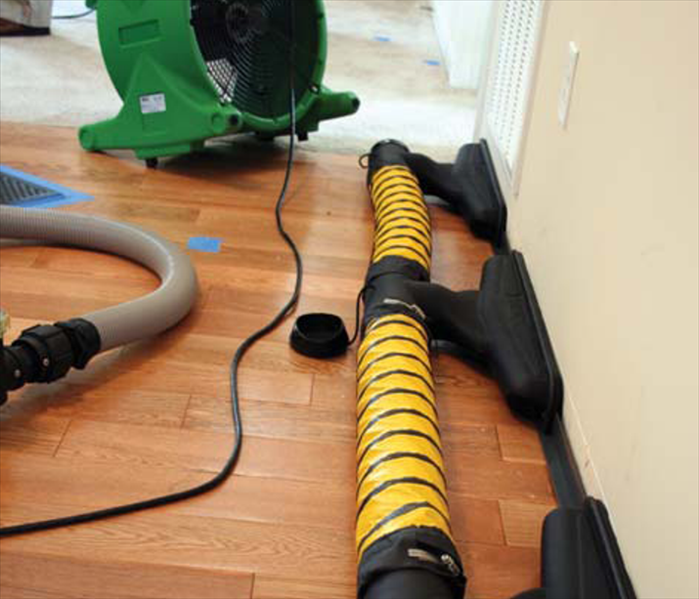 Specialized water damage drying equipment drying a wall cavity resulting in minimal repairs costs.
Specialized water damage drying equipment drying a wall cavity resulting in minimal repairs costs.
DID YOU KNOW there is actually a science behind the process of drying? Having the knowledge of psychrometrics is essential to restoring a water damaged structure to its preloss condition. While your initial reaction may be to grab a few towels to mop up the mess and place a fan or two around the damaged area, SERVPRO® of Wayne professionals are trained in the science of drying and follow strict industry approved standards to help lower the chances of any secondary damages. If your home or business suffers a water damage, SERVPRO® of Wayne Professionals will:
- Inspect the building to detect every component that is wet, to help prevent secondary damage from happening.
- Measure how much moisture is in wet materials and monitor whether the materials are drying properly.
- Speed up Mother Nature by using professional drying equipment.
What exactly does it mean to help “speed up Mother Nature”? A wet building can often dry naturally because the environment always seeks equilibrium. When materials are wet, moisture will naturally move to drier air at the surface of the material–but only if the air is, indeed, drier. Th e only problem is, nature takes too long and secondary damages may occur while the building is drying out.
SERVPRO® of Wayne Professionals have the tools and equipment to help Mother Nature along, including equipment to help dryhardwood floors, tough-to-reach spaces inside walls (pictured below), and much more. SERVPRO® of Wayne Professionals also use state-of-the-art monitoring equipment, and a proven scientific process to help speed the drying of your home or business.
The bottom line? SERVPRO® of Wayne Professionals have the training and equipment to help make water damage “Like it never even happened.”
Be Storm Smart, Be Storm Ready
4/21/2016 (Permalink)
Severe weather can happen any time, anywhere. Each year, Americans cope with an average of the following intense storms*:
- 10,000 severe thunderstorms
- 5,000 floods or flash floods
- 1,000 tornadoes
- 2 landfalling deadly hurricanes
Approximately 98 percent of all presidentially declared disasters are weather-related, leading to around 500 deaths per year and nearly $15 billion in damage. * Knowing your risk of severe weather, taking action and being an example are just a few steps you can take to be better prepared to save your life and assist in saving the lives of others.
Know Your Risk.
The first step to becoming weather-ready is to understand the type of hazardous weather that can affect where you live and work, and how the weather could impact you, your business and your family. Check the weather forecast regularly, obtain a NOAA Weather Radio, and learn about Wireless Emergency Alerts. Severe weather comes in many forms and your shelter plan should include all types of local hazards.
Take Action.
Take the next step in severe weather preparedness by creating a communications plan for your home and business. Put together or purchase an emergency kit. Keep important papers and valuables in a safe place.
Be an Example.
Once you have taken action to prepare for severe weather, share your story with co-workers and family and friends on Facebook or Twitter. Your preparedness story will inspire others to do the same.
Build An Emergency Supply Kit
- Water (one gallon per person per day)
- Food (non-perishable 3-day supply)
- Manual can opener
- Battery operated radio, preferably a NOAA Weather Radio
- Flashlight and extra batteries
- First aid kit
- Whistle to signal for help
- Clothing
- Dust masks or bandanas
- Plastic sheeting, garbage bags and duct tape
- Wrench or pliers to turn off utilities
- Hygiene items
- Important documents; copies of insurance policies, identification and bank account information
- Cash
- Fire extinguisher
- Matches in a waterproof container
Contact SERVPRO® of Wayne for more readiness tips and tools, including SERVPRO’s Emergency READY Profile® (ERP). Having an ERP in place for your facility can help minimize business interruption in the event of a disaster.
Contact SERVPRO® to learn more and be “Ready for whatever happens!”
LIKE Us Facebook!
What To Do Until Help Arrives
11/21/2015 (Permalink)
EMERGENCY TIPS FOR YOUR HOME
Please follow these DOs and DON’Ts to help reduce damage and increase the chances of a successful restoration.
CLEAN WATER DAMAGE
DO:
Shut off the source of water if possible or contact a qualified party to stop the water source.Turn off circuit breakers for wet areas of the building, when access to the power distribution panel is safe from electrical shock.Remove as much excess water as possible by mopping and blotting.Wipe excess water from wood furniture after removing lamps and tabletop items.Remove and prop up wet upholstery cushions for even drying.Place aluminum foil or wood blocks between furniture legs and wet carpeting.Remove to a safe, dry place any paintings, art objects, computers, documents and other materials that are valuable or sensitive to moisture.Use wooden clothespins to keep furniture skirting off damp floors.Hang draperies with coated hangers to avoid contact with wet carpeting or floors.Hang furs and leather goods to dry separately at room temperature.DON'T
Enter rooms with standing water where electrical shock hazards may exist.Enter affected areas if electrical outlets, switches, circuit breakers or electrical equipment are exposed to water. Always avoid electrical shock hazards.Leave books, newspapers, magazines or other colored items on wet carpets or floors to cause staining.Leave Oriental rugs or other colored rugs on wet wall-to-wall carpets to cause staining.Use your household vacuum cleaner to remove water, possibly causing electrical shock or damage to the vacuum cleaner.Use TVs or other appliances while standing on wet carpets or floors, especially not on wet concrete floors.Turn on ceiling fixtures if ceiling is wet or enter rooms where ceilings are sagging from retained water.CONTAMINATED WATER DAMAGE
DO
Avoid all contact with sewage and items contaminated by sewage.Wash your hands thoroughly after contact with contaminated items.DON'T
Spread contaminated water by walking unnecessarily on damaged or wet areas.Turn on the HVAC system if there is a possibility of spreading contaminated air.Use household fans to dry the structure and spread contaminants.Use products for personal hygiene and cleanliness if exposed to the contaminated areas.HARMFUL WASTE
DO
Stay out of affected areas.Call emergency service personnel if the situation is life-threatening.Treat all bodily fluids as if they are contaminated.DON'T
Attempt cleanup of any kind.Touch or handle items that might be contaminated with bodily fluids.
Winter Weather
11/19/2015 (Permalink)
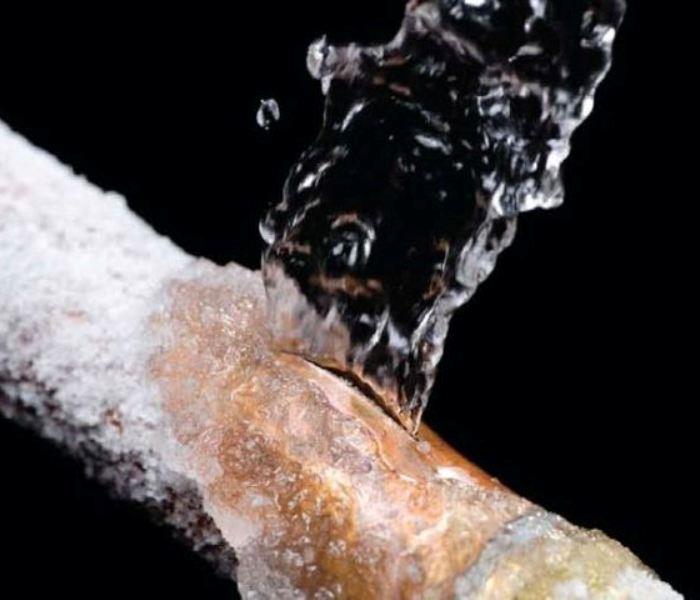 Frozen Pipe
Frozen Pipe
Tips for Preparing Your Home or Business for Winter Weather
PREPARE YOUR BUSINESS
Check your business property for downed tree limbs and branches. Weather, such as wind, heavy rain, ice and snow, can cause branches to fall, which could cause damage to the property and potentially cause personal injuries.Inspect property, especially walkways and parking lots, for proper drainage to alleviate flood hazard potential.Inspect all handrails, stairwells and entryways to address and correct potential slippery or hazardous areas. Install mats or non-slip surfaces and post caution signs where water could be present.Ask SERVPRO of Wayne about starting a Disaster Recovery Plan for your business.PREPARE YOUR HOME
Keep cabinet doors open during cold spells. This allows warm air to circulate around pipes.Keep a slow trickle of water flowing through faucets, especially if the pipes for faucets run through unheated or uninsulated areas of your home.Consider shutting off outdoor faucets. Find the shut-off valve in the basement or crawl space and turn it to “off.”If you follow the previous step, then open the outdoor faucet to help ensure it drains completely and the inner valve is shut off.Ensure gutters are clean and secure. Leaves and debris accumulate, causing a damming effect on gutters, which could lead to roof problems and water damage.Proper maintenance of your furnace can help reduce the risk of puff-backs.FROZEN PIPES
A frozen pipe can burst at the point where the ice blockage inside the pipe is located, but typically the rupture is caused by the backflow pressure between the water source and the blockage. A burst pipe can cause considerable damage to your property if not addressed quickly. SERVPRO of Wayne is faster to any size disaster, bringing the latest equipment and training to help make your water damage “Like it never even happened.”
ICE DAMS
Ice dams can be a major problem during the winter season. They form when heated air melts roof snow downward into water dammed behind still-frozen ice.
When the trapped water cannot safely flow or run into the gutter system, it can backflow under the roof ’s shingles and into the structure’s interior areas. SERVPRO of Wayne can help mitigate water damage caused by ice dams and help you get your structure back to pre-loss condition.
PUFFBACKS
A puff back is a messy furnace malfunction that occurs when an oil burner backfires, sending soot throughout your home or business. It can happen all at once, covering an interior in grimy soot, or a puff back can leak soot particles more gradually. Equipped with the training, tools and experience to quickly and efficiently clean and restore your home or business, your SERVPRO of Wayne will help make your puff back “Like it never even happened.”
FLU SEASON
Help prevent the spread of flu germs. Homes and businesses can depend on their local SERVPRO® Franchise Professional to clean and sanitize building materials, surfaces and contents following restoration industry standards, using professional cleaning products and EPA-registered cleaners and disinfectants. SERVPRO of Wayne is also trained and equipped to clean your HVAC and duct systems to help provide better air quality and help reduce the risk of circulating harmful contaminants.
Property Restoration Can Be a Messy Business
9/18/2015 (Permalink)
Below is a recent press release regarding our efficiency and proprietary technology:
Local disaster recovery specialist offers insight into the complexities of dealing with disaster.
When disaster strikes, property owners need to make a lot of decisions quickly and under pressure. Effective disaster remediation involves a lot of moving parts: remediation specialists, insurance companies, local codes, state codes, documentation and more—and all of this has to happen in an atmosphere charged with emotion and stress.
Cody Sullins of SERVPRO® of Christian, Todd, Logan & Simpson Counties says, “Efficiency is key when you are dealing with disaster remediation; it saves our customers money and it makes our work more effective. SERVPRO is an industry leader in work efficiency technology—continually innovating to help both our customers and our business control costs.”
SERVPRO’s proprietary DryBook™ tool is one example of the company’s focus on efficiency and cost control. Remediation projects must be managed to both industry and insurance company standards, and Sullins says tools like DryBook™ help SERVPRO Franchise technicians track and document progress on restoration, cleanup and repair services. “The DryBook™ tool helps us deliver on every detail of every water damage job, every time,” says Sullins.
To help avoid regulatory headaches and paperwork pitfalls, Sullins suggests property owners consider the following criteria when choosing a remediation company to deal with the aftermath of a disaster.
1. Industry standards: Does your remediation company deliver a product that meets the standards set by
• The Institute of Inspection, Cleaning and Restoration Cleaning (IICRC)?
• Most major insurance companies, including cycle times and deadline requirements?
2. Recordkeeping: Does your remediation company have a system in place to ensure accurate, complete and convenient benchmarking of each step of the remediation process, including
• Capturing and updating data, including job diary notes, electronically real-time on the jobsite, with simultaneous updates saved at the central office?
• Using e-signatures to help eliminate lost paperwork and the need to scan documents?
• Providing a complete record of the damage and remediation efforts in images, with descriptions, start-to-finish?
3. Equipment selection: Does your contractor have the ability, on-the-spot, to
• Identify the right equipment for the job, based on the damage description?
• Validate the use of each piece of equipment, automatically, as part of the remediation records?






 24/7 Emergency Service
24/7 Emergency Service


























